1 Volumes
Rt. Angle by Years
The history of Philadelphia"s finest men's club.
Right Angle Club 2008
A report, to the year 2008 shareholders of the Right Angle Club of Philadelphia, by the outgoing president, Neale Bringhurst...
REFERENCES
| The Right Angle Annual Reports 2008 George Ross Fisher MD | Ross and Perry Inc. |

RIGHT ANGLE CLUB PRESIDENT'S LETTER
Dear Fellow Members of the Right Angle Club,
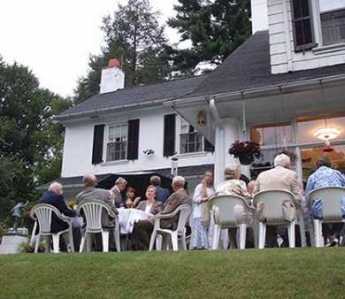
|
| Picnic |

|
| Jack Nixon |

|
| Dan Sossaman |
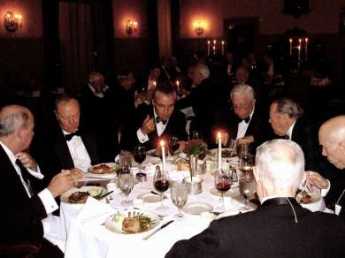
|
| Presidents Dinner |
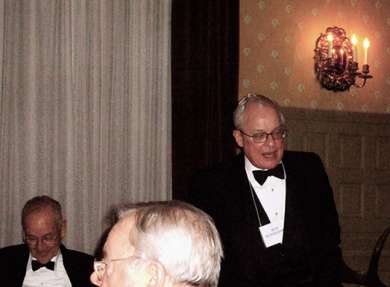
|
| Rod Rothermel |
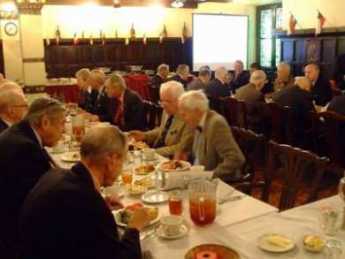
|
| Lunch |
.JPG)
|
| Alan Lawley |

|
| Rosie |
SCUBA Tours of the Andrea Doria
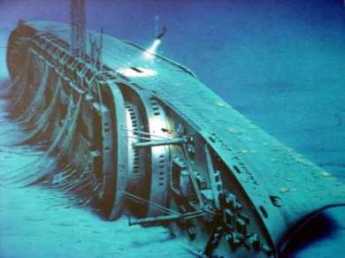
|
| The Andrea Doria Wreck |
Robert J. Burns, who runs clinical trials of medical instruments at Boston Scientific, on July 25,2008 told the Right Angle Club about what he does on weekends. It seems to amount to coming within an inch of getting killed, scuba diving. His favorite place to visit is the sunken wreck of the Andrea Doria, lying on its side in 250 feet of water, forty-five miles from Block Island in international waters. Built in 1951 in grand style, the Andrea Doria was the pride of the Italian ocean fleet, with 190 First Class passengers, 267 Cabin Class, and 677 Tourist Class. There were about 600 crew members aboard. Two of the passengers on July 25, 1956, were Mayor Richardson Dilworth of Philadelphia and his wife, so when it sank, the Andrea Doria dominated the news. After it was all unscrambled later, it seems the radar of the liner Stockholm had incorrect markings and misled the helmsman into thinking distances were five times greater than they actually were. On a day of dense fog, the Stockholm knew the Andrea Doria was near, but greatly underestimated how near. When the Stockholm suddenly found the Andrea Doria looming up, the helm was sharply turned in both ships, causing the prow of the Stockholm to gouge out most of the side of the Doria, which soon sank. That would ultimately mean the Stockholm was mainly at fault, but the Italian liner's image was as damaged as its hull by having the crew commandeer the lifeboats for themselves and essentially abandon the passengers. The rescuing ship was the Ile de France, who told the newspapers that at first, they thought they were rescuing an all-male ship. It's not completely certain how many people were killed in the collision; between 47 and 52 individuals were missing. A matter of great interest to the news media was the story of an 11-year old girl on the Andrea Doria, who was scooped out of her cabin by the prow of the Stockholm and eventually located safe and sound in the bow of the Swedish ship.
Because of German submarine activity in World War II, the Atlantic coast is littered with sunken ships from Boston to North Carolina. Most of them attract great schools of fish and scuba divers, but the Andrea Doria is a favorite because of all the souvenirs to be found on it. Three classes of dining rooms provide tons of monogrammed dishes and tableware, greatly in demand for the trophy cabinets of avid scuba enthusiasts. Just about the first salvage hunter was Peter Gimbel of the department store family, who cut a hole in the first class area and liberated the safe which might be presumed to be full of jewels. As it turned out, it only held some well-soaked Italian currency.
Scuba diving at a depth of 250 feet requires a certificate, and $7000 worth of training for five years is required just to be eligible to risk your life. Even so, plenty of people have lost their lives playing this game, whose central thrill seems to be that you have to get dozens of maneuvers right, every single time, or you've had it. The Martini effect is probably a big part of it, too. Every fifty feet of depth gives a degree of narcosis equal to drinking one Martini, so a diver to the Andrea Doria operates as if he had drunk five Martinis. Under those circumstances, judgment gets clouded but every single knob on every single hose has to be adjusted every so many minutes, adding and subtracting oxygen, substituting helium for nitrogen, and modifying the pressure and flow rates. Then, because it's dark down there, you have to remember to turn left after ten feet, then right after twenty feet, and reverse it all when you come back out with your monogrammed dish. Deep sea diving with a hard hat is safer and more comfortable because you are attached to a hose and have a handler upon the surface keeping track of things for you. But hoses would get cut by the jagged edges of the interior of the hulk, and all in all, diving with a hard hat just isn't what real men do. The hard hat may offer some protection against the myriads of sharks to be encountered, but that's only if the shark prefers to attack your head. If you are using a lot of helium in your breathing mixture, you tend to get very cold, and the preferred answer is to wear a suit inflated with Argon. If that gets punctured by sharks or one thing or another, the discomfort can be memorable. It's cold, it's dangerous, it's dark, it's lonesome, but think of all those dishes you can collect. And maybe the five Martinis are part of the attraction, too.
www.Philadelphia-Reflections.com/blog/1499.htm
Philosophy Means Science in Philadelphia
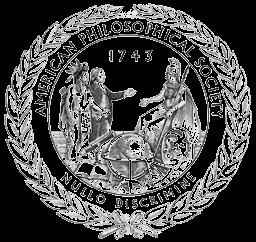
|
| American Philosophical Society Seal |
In the age of the Enlightenment, science was called natural philosophy; that accounts for the present custom of awarding PhD. degrees in chemistry and botany. The sort of thing which interested Ralph Waldo Emerson was called moral philosophy, and you will have to visit some other place than the A.P.S. if that is what interests you. Roy E. Goodman is presently the Curator of Printed Material (some would say he was chief librarian) at the American Philosophical Society, founded in 1743 by Benjamin Franklin who was clearly the most eminent scientist of his day, having discovered and explained the nature of electricity.
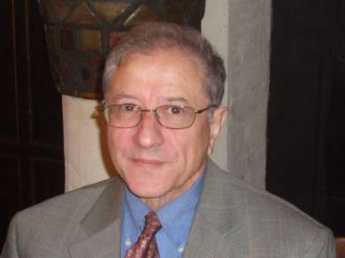
|
| Roy E. Goodman |
Roy Goodman is descended from cowboys and rodeo stars, but in spite of that he gave an entertaining talk recently at the Right Angle Club about this society devoted to useful knowledge, this oldest publishing house and scholarly society in America, once the home of the U.S. Patent Office, and scientific library and museum. They have many rare items in their collection, but the unifying theme is not a rarity, but curiosity. You might say some of the items reflect the whimsy of Franklin, but it would be fairer to say it is an enduring monument to Franklin's universal curiosity about all things.

|
| Nobel Prize Medal |
There are about 900 members of APS, about 800 of them Americans, about 100 of them winners of a Nobel Prize. Let's just make a little list of a very few notables in the past and present membership. Start with the first four Presidents of the United States, add Alexander Hamilton and Lafayette, David Rittenhouse and Francis Hopkinson and you get the idea that Founding Fathers got in early. Robert Fulton, Lewis and Clark, Alexander Humboldt, John Marshall were early members, and more recent ones were Madame Curie,
Pakistan and Democracy
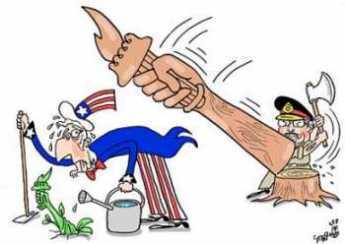
|
| Pakistan's Democracy |
The Philadelphia Right Angle Club has mainly local speakers, so topics tend to concentrate on the Philadelphia scene. Recently, a Philadelphia resident was asked to speak, and chose the intriguing topic of the lack of democracy in Pakistan. Explaining, to general surprise, why that lack may be inevitable in all undeveloped countries, and therefore not to be criticized too harshly in this one.
As a starting generalization, he pointed out that democracy is almost never found in countries where the average annual income is less than $6000, and almost universally found in countries where income is above that level. The main exception is India, which was described as having a "sham" democracy. Historical exceptions like ancient Athens and Iceland were not elaborated upon, so perhaps it might be better to say poverty is a hindrance to democracy, and let it go at that. The general idea is that Pakistan needs to get more prosperous, and particularly needs to get rid of the things making it less prosperous. When that's accomplished, democracy will establish itself without help. At the very least it cannot be expected to establish itself before then. One subtle jibe at the British (and the American Democrat party) is the point that it helps establish democracy if everybody is a taxpayer, not just the filthy rich. Democracy is helped to emerge when universal taxation provokes a demand for universal representation. Even a second historical echo might have been hidden in our speaker's pointing out that because much of Pakistan is in the feudal hands of two hundred families; the poor serfs of their fiefdoms invariably vote as their owner wishes, thus leading to a small political oligarchy. Americans were not twitted, but might have been, whether the Pakistan constitution should have imitated our own provision for 3/5 votes for slaves.
To go back to poverty itself, it is probably possible to editorialize that other main factors hindering democracy's development could be viewed as expedients evolved to sustain a functioning society in the midst of poverty, or are inherent limitations of poverty. Like lack of education, overpopulation defined as a ratio of population to resources, ethnic enclaves organized around religious leaders, feudal systems of self-defense, and vulnerability to invasion leading to overspending on defense. Even the suppression of women can be viewed as a poor, weak society's way of sustaining the number of soldiers while cutting the number of people needing costly education by half. These are not congenial concepts for Americans, but it must be granted they have importance if you adopt our speaker's central thesis: the military government of Pakistan may be the least bad choice now available to that country. At least two other epigrams touch the same conclusion: survival may temporarily seem more important than democracy, and/or democracy may be unachievable until prosperity is first achieved by authoritarianism. That last one is really uncomfortable, because it may imply that revolution is the second step in a three-step process.
Meanwhile, we have to be sympathetic with Pakistan's struggle with a problem any fair-minded person would agree is not an easy one. Their country is a series of valleys between some of the highest mountains in the world, with the rest of the countryside either desert or in contention with India. Pakistani must police a border cut down the middle of the mountains by the British, separating two portions of the same tribe who share the common bond of survival in the harshest climate in the world. They are in constant international contention with India, both sides brandishing nuclear arms. The bitterness of the Israeli-Palestine conflict inflames religious sentiment. America pursues its international interests within Pakistan's borders and against some who are regarded as fellow tribesmen, certainly co-religionists. The opium trade from Afghanistan infiltrates the borders. The nation is composed of five feudal states, united only in their annoyance with Moslem immigrants from India who are better educated than the locals, and who offend the local cultures with jarring dissimilarities. And finally, Bin Laden and his fellow Wahhabi zealots are in their midst, funded with vast amounts of Saudi money to pursue worldwide disruptions, hotly pursued by Americans who are not of their religion and not particularly careful of local sensitivities. Under the circumstances, perhaps our demand that they adopt a perfect democracy, and right now, is understandably exasperating.
www.Philadelphia-Reflections.com/blog/1524.htm
World Finance, Columbus Day 2008

|
| Prime Minister Gordon Brown |
WITH voters watching three weeks before the 2008 American presidential election day, finance ministers and their political masters met to decide a basic question: dare they risk disaster to save the existing system, or play it safe by sacrificing small banks to rescue big ones? That is, guess if the situation is so bad only strong rowers can be allowed in the lifeboat, or whether things are really manageable enough to try to save everybody but at the risk of worse consequences for failure. For example the credit default swap mystery; there are $60 trillion notional value insurance policies in existence to cover $20 trillion of bonds. Is that massive double-counting, or an actual disaster so severe it makes every other consideration trivial? Answer quick, please, the ship looks like it might sink. At first, it seemed strange a Labor government in England would propose saving only the strong until you realize that Prime Minister Brown is protected from his Left, while the Democrats in America want to use a fairness argument to win their election. A Republican lame-duck president must do the deciding, a man who has been shown to be both a tough politician and a fearless gambler; playing things safe is not his style. The Dow Jones average soared a thousand points in a day's trading on the prayer that things were finally under control. But take a look around.
Little Iceland and Switzerland are proud to house some enormous banks. But if those banks approach failure, their homeland treasuries are far too small to bail them out.
On the other hand, little Hungary has a negligible banking system, so Hungarians commonly borrow money from foreign banks. The national currency devalued by half in this crisis, so most Hungarian mortgages doubled in price. Reserve systems based on national governments suddenly look obsolete.
Try another approach. Little Ireland went ahead and guaranteed all deposits in its financial institutions. Money from England and the rest of Europe immediately poured in to enjoy that guarantee, forcing other grumpy nations to match the unwise Irish offer. There's a sense that nations are losing control of their affairs.
Europe consists of 27 nations, of which fifteen are in the Euro zone. There are common currency and a constrained central bank, but can this gaggle of geese possibly agree on concerted action in this crisis? America was once in this situation under the Articles of Confederation, but even after almost losing the Revolutionary War, George Washington was nearly unable to get the colonies to form a union. Even after this experience, the Southern Confederate States later adopted the same system of a central currency without a central government and really did lose their war.
Are we to infer from Prime Minister Brown's attitude toward banks that he might soon suggest ditching little nations in order to save bigger ones?
www.Philadelphia-Reflections.com/blog/1525.htm
WRTI, Classical Music and Jazz
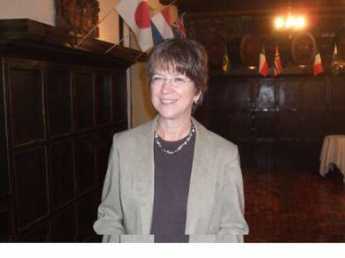
|
| Susan Lewis |
Susan Lewis recently entertained the Right Angle Club with a description of her life as the scriptwriter for WRTI, the local classical music station. WRTI could be described as one of three local affiliates of National Public Radio, the network content provider headquartered in Washington DC. The other two are WHYY, a talk station, and WXPN, the University of Pennsylvania station devoted to folk, rock, blues and root music. Another way of describing WRTI is that it took over the role formerly served by WFLN before it was sold, incorporating it into Temple University's jazz station. It plays classical music from 6AM to 6PM, and then plays jazz in the evening. Philadelphia thus really only has half a classical music station, when most cities who are home to a major orchestra have at least two. It is not clear whether this anomaly is a comment on the local radio climate or the future of its musical one.
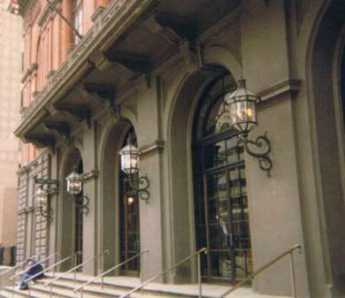
|
| Philadelphia Opera House |
The question came up as to just what is classical music since there are turf boundaries for the affiliates of National Public Radio. Susan Lewis, who has the surprising background of being a former corporate lawyer has apparently given this some thought. She offers the opinion that classical music overwhelmingly consists of music with multiple performers. Orchestras, opera, chorales, and chamber music characterize the topic more than pre-contemporary origins. A brand new symphony would naturally fall into the classical music category, while songs by Frank Sinatra would not, even though excited announcers might call his songs classics. Following this theme, classical music seems to fit with jazz, which consists of several soloists working on variants of a common theme. The sad question thus comes up whether Philadelphia's declining interest in classical music might in some way reflect social fragmentation within a metropolitan community which historically has highly valued cooperation and consensus. One hopes that's not the case.

|
| WRTI RADIO |
Playing a succession of recorded musical selections sounds as though it would be a low-budget operation, but WRTI costs $3.6 million to run, annually. The scriptwriter gets up early, reads the day's artistic news and events, and some auto traffic reports, and records one-minute vocal interludes between the pieces of music. About once a week, a special seven-minute segment is assembled from excerpts from interviews or interludes relating to a theme in the artistic world. One taped recording of carillon music and commentary proved to be quite charming and entertaining, including the news that the carillon in Holy Trinity Church is the oldest in America. Since a bell is a variant of a tuning fork, the bells of a carillon chime with a very long period of decay, creating a problem for both composer and performer to avoid successive notes which conflict unless there is a long pause. These magazine-like pieces of hers are always organized around a main emotional "hook" of some sort, and Susan finds they are very time-consuming to assemble. That leads to a constant succession of inflexible deadlines, just like lawyers' briefs before a legal deadline, generating an excitement strangely exhilarating to the participant, and highly mystifying to outsiders.
As the central focus for dozens of emails and text messages about the goings-on of the local artistic world, the job of town gossip for the art world is an ego trip only suitable for a person who revels, with affection, in the endless wealth of art and anecdote in Philadelphia. As bloggers also know, this job constantly surfaces interesting news tidbits that surprise and please many people. Like the fact that William Penn's hat on top of City Hall is filled with graffiti. Or that a secret colony of Lenni Lenape Indians still exists in town. Or that the forthcoming HP radio standard produces outstandingly high quality.
Ms. Lewis is an asset to our town.
www.Philadelphia-Reflections.com/blog/1521.htm
John Head, His Book of Account, 1718-1753
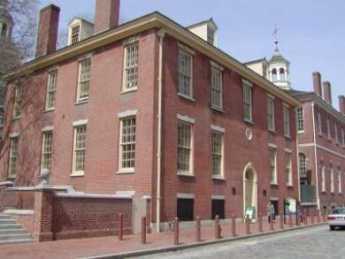
|
| American Philosophical Society |
Jay Robert Stiefel of of the Friends Advisory Board to the Library of the American Philosophical Society entertained the Right Angle Club at lunch recently, and among other things managed a brilliant demonstration of what real scholarship can accomplish. It's hard to imagine why the Vaux family, who lived on the grounds of what is now the Chestnut Hill Hospital and occasionally rode in Bentleys to the local train station, would keep a book of receipts of their cabinet maker ancestor for nearly three hundred years. But they did, and it's even harder to see why Jay Stiefel would devote long hours to puzzling over the receipts and payments for cabinets and clock cases of a 1720 joiner. Somehow he recognized that the shop activities of a wilderness village of 5000 residents encoded an important story of the Industrial Revolution, the economic difficulties of colonies, and the foundations of modern commerce. Just as the Rosetta stone told a story for thousands of years that no one troubled to read, John Head's account book told another one that sat unnoticed on that library shelf for six generations.
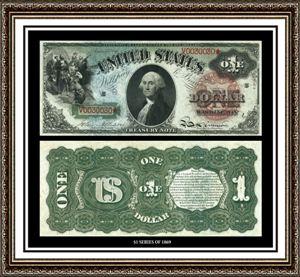
|
| Colonial Money |
The first story is an obvious one. Money in colonial days was mainly an entry in everybody's account book; today it is mainly an entry in computers. In the intervening three centuries, coins and currency made an appearance, flourished for a while as the tangible symbol of money, and then declined. Although Great Britain did not totally prohibit paper money in the colonies until 1775, in John Head's day, from 1718 to 1754, paper money was scarce and coins hard to come by. Because it was so easy to counterfeit paper money on the crude printing presses of the day, paper money was always questionable. Meanwhile, the balance of trade was so heavily in the direction of the colonies that the balance of payments was toward England. What few coins there were, quickly disappeared back to England, while local colonial commerce nearly strangled. The Quakers of Philadelphia all maintained careful books of account, and when it seemed a transaction was completed, the individual account books of buyer and seller were "squared". The credit default swap "crisis" of 2008 could be said to be a sharp reminder that we have returned to bookkeeping entries, but have badly neglected the Quaker process of squaring accounts. As the general public slowly acquires computer power of its own, it is slowly recognizing how far the banks, telephone companies, and department stores have wandered from routine mutual account reconciliation.
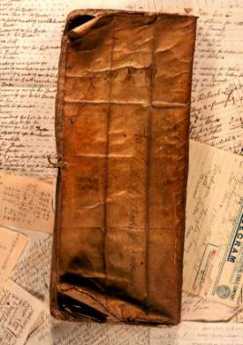
|
| John Head's Account Book |
From John Head's careful notations we learn it was routine for payment to be stretched out for months, but no interest was charged for late payment and no discounts were offered for ready money. It would be another century before it became routinely apparent that interest was the rent charged for money and the risk of intervening inflation, before final payment. In this way, artisans learned to be bankers.
And artisans learned to be merchants, too. In the little village of Philadelphia, chairs became part of the monetary system. In bartering cabinets for the money, John Head did not make chairs in his shop at 3rd and Mulberry (Arch Street) but would take them in partial payment for a cabinet, and then sell the chairs for the money. Many artisans made single components but nearly everyone was forced into bartering general furniture. Nobody was paid a salary. Indentured servants, apprenticeships trading labor for training, and even slavery benignly conducted, can be partially seen as efforts to construct an industrial society without payrolls. Everybody was in daily commerce with everybody else. Out of this constant trading came the efficiency step for which Quakers are famous: one price, no haggling.
One other thing jumps out at the modern reader from this book of account. No taxes. When taxes came, we had a revolution.
www.Philadelphia-Reflections.com/blog/1517.htm
Use the Internet for Your Club
Most clubs, family groups, or neighborhood associations are held together by one loyal volunteer who does all the work. This limits the scope of the club to what one person is able to do in spare time. When that central person gets tired of it or moves away, things tend to fall apart. In the spirit of encouraging more volunteerism, this article suggests some ways the home computer can easily automate the normal drudgery of running a club. Having just performed this task for the local computer society, I can report it takes about two hours to put it together. If I did it three times, it would take forty-five minutes. A rank beginner, who doesn't even know what the words mean, might take all day to do it, but no more than that.
Most of the programs a club would need were first developed for people on the go, like a salesman who visits several cities, or a college student who commutes. It's an easy step to imagine different club members in different places instead of one person in several places. Electricity travels so fast that connecting computers together over the whole world's Internet can be thought of as essentially creating one big computer. For practical purposes, it doesn't matter whether a piece of information is in two parts of one computer or in two different computers hooked together by the Internet. The whole process is so cheap it might just as well be free.

|
| The New Macintosh Mac Mini |
Selection of Computer and Operating System. Over ninety percent of the world's home computers are based on the Windows operating system, but Windows is having a lot of trouble right now with viruses and spam. Right now is Apple's big chance, because the Apple OS X operating system, based on Unix, seems to be immune to viruses and spam. So, if you are buying a new computer, I suggest you look at Apple's headless version. That's a little six-inch box to which you attach the monitor, keyboard, and printer that presumably you have left over from some Windows system. Times will change, but right now this five hundred dollar little headless job is worth the money. That's for the club secretary; all the club members can use any kind of machine they happen to have, at least for read-only use.
Router. If you have several computers on one telephone line, you need a router to send the right signals to each machine. Because the router changes the identification numbers every time it is restarted, it tends to foil the buccaneers out there who are trying to find your credit card. Therefore, it's not a bad idea to have a router attached, even if you only have it connected to a single computer. Security folks say it takes about fifteen minutes for some buccaneer to find a newly installed computer, and most banks get several hundred break-in attempts every hour. That's because everybody is getting automated these days, including criminals.
Choice of Browser. After you get set up and organized and all, you need to download the Fire fox browser, which right now is faster and more spam-proof than either Internet Explorer or Netscape. Go to some other browser and enter https://www.mozilla.org/products/firefox/. There's no harm in having several browsers sitting on your computer, including Opera if you like, but right now Firefox is the one to use. A browser, in case you care, is a program that takes a stream of Internet data and translates it into the image on your screen, sort of like translating Morse code into a telegram. Some browsers are lean, mean and fast, while others are loaded with a lot of bells and whistles that slow them down. If you can't see any difference by trying them, go with the one that gives you most spam protection.

|
| Yahoo Calendar |
Yahoo Calendar. There are lots of computer calendars, but right now Yahoo offers one that is somewhat better for public use by clubs. For an illustration, take a look at the Philadelphia Orchestra calendar that can be located on Philadelphia Reflections in the lower left column, by first clicking the Philadelphia Calendars button, and then clicking the link to the Orchestra's schedule. Naturally, the Orchestra doesn't want people changing their public schedule, so the calendar is read-only. You can create a calendar like this for your club or organization by going to www.calendar.yahoo.com and entering an identifier and password. You can only change the calendar if you have the password, so be careful who is allowed to have it. If you make a misjudgment about this, just abandon the calendar and start a new one. You can, of course, create a personal calendar for yourself; it would be nice to merge your calendar with organization calendars. Calendar-merge programs do exist but presently are a little primitive. Even nicer would be the ability to drag and drop individual events from one calendar to the other, but that's mostly on the wish list.
Yahoo Address Book. There are zillions of address books, but Yahoo provides a public one if you allow club members to know the password. On the one hand, it's a big convenience for the secretary to have everybody fill in his own data. It can take ten or fifteen minutes apiece to complete all that information. On the other hand, if just anybody can have all this data, you can expect to get lots of unwanted solicitations. Naturally, you want to keep intruders from altering the data, but whether or not you make your membership list public is your own decision. So, probably you want to transfer the data to a list that you keep private, using a system of letting people enter data, and then erasing it after it is transferred.
Listserv. A very handy tool is to create a listserv, which is a system of e-mail that is sent to everyone on the list, and everyone can chime in with comments. It makes for a lot of local excitement, and it keeps families together, including reunion classes from all the schools you went to, 'way back then. If the Rs and the Ds get to bashing each other on the Listserv, you will learn the value of designating some sober soul to be list master, given the power to exile people whose mouths get too noisy.
Minutes and History as Blogs. Most clubs keep minutes, and after a while, they start to record their history. It's a lot of work, and often gets lost; furthermore, it's hard for anyone but the author to read. We suggest you create a blog and hang it on the Internet.
While there are a dozen programs and systems for creating blogs (that's short for Web logs), Google has bought blogger.com from that company, and has pepped it up quite a lot. Like the rest of these ideas, this one is free, and there are several million of these in existence. Sometimes people write poetry in the form of blogs, and some other people put up some pretty raunchy pictures or commentary. Apparently, Google doesn't care, so they shouldn't mind if you publish the minutes of the East Whipswitch Cooking Society as blogs. It's very easy to do, and their canned templates produce some pretty elegant web sites in minutes. That's right, minutes in minutes.
Finances and Newsletters. Clubs typically collect dues or charge for luncheons, but financial stuff on the Internet is more complicated and must be dealt with in a later article. Similarly, you can publish a newsletter using RSS that is very spiffy indeed, but that's really hard to explain, and must be described in a separate article, too. Anyway, these preliminary items are enough to keep a new club busy for a few months.
Fast User Switching. Other operating systems will surely imitate it, but Apple is at present where you have to go to make a separate computer section for your club. Apple originally had the idea that several people would use the same machine, and want to keep their data secret from each other. So, they have a system in which you can click the upper right corner of the screen, and you can place yourself in a secret room with its own password. We suggest that it would be better to see this as a new desktop. All graphical interfaces of all computer operating systems use the metaphor of a desktop, which is what suggested to me that the club needs a desktop like my own. That is, it's littered with half-finished business of a dozen sorts, suddenly abandoned when the phone rings or a visitor arrives. You would like to be able to come back to your desktop and take up your work where you left off. For that, you probably need several desktops, and that's what fast user shifting provides you. Not vitally essential, but very convenient.
Favicons. Especially if you have fast user desktops specially designated by work topics instead of people, you can really use the favicon, or favorite icon, feature. A favicon is the little miniature do-hickey to the left of the webpage URL in the URL box. Maybe you never noticed it, but it's usually there. If you take your mouse and drag the favicon onto the desktop (you may have to shift something to create some blue sky desktop room) a new icon will appear on the desktop. Close up and click on that new icon, and you will open up a browser and go right to the page you were using when you created the icon. This is such a really neat feature that your desktop is apt to fill up quickly with a lot of web pages you happened to come across. It doesn't take long for the favicons to choke the desktop into uselessness, so this feature is at its best in a system where the topics of general utility to the user are sub-set by fast user switching.

|
|
Apache has the largest share of the market and is available for most computers. |
Your Own Website. Apache. Your club will soon get the idea that you need your own website, but in fact, you already have several of them. Your calendar, address book, club minutes blog, club history blog already add up to four websites. To most people, having their own website means consolidating all this material into one elegant page, with photos and artwork. You can do that, but it's much harder, and you first need to see if you really have a need for that. By far the easiest way for amateurs to have a website is to pay somebody a couple hundred dollars to write the code for it, and pay an Internet provider ten or twenty dollars a month to display it for you.
But for advanced players, like a club of computer professionals and particularly if that club runs a little on the snooty side and highly prizes its privacy, it might want to consider going all the way and becoming its own Internet provider. In that rather special case, it brings us back to Apple, since the OS X system includes a free copy of Apache, the program for running your own site on your own computer. Now, that's really a big undertaking, far beyond the average club. So if privacy of that order is mandatory, you may have to hire someone to set it up for you. But Apache sure makes it possible, if that's where you feel you want to go.
Your Own Newslettter. First, take a look at what you are trying to achieve, and a handy example would be https://www.yahoo.com/.

|
| Yahoo |
You will see it is not a daily or a weekly, it is continuous. The page of the newspaper is a montage of ten or twelve blocks on a page. For example, one block might display the month's schedule, another shows sports scores, another shows the stock market, etc. Each one of those blocks is probably updated at a different time, making this a continuous newsletter. Of course there is a way provided to individualize the blocks of space, change the color schemes, etc. Since this newsletter is on the Internet, anyone can read it from anywhere in the world, at any time. That is, they can read it if they know the password, which some clubs want to keep private, and others prefer to skip because it is a nuisance when people forget what the password is and call you up at home after midnight to ask for it.
What underlies this process is a technique known as RSS. Each block of space in the newspaper is operating on a different scheduling, and each blocks "polls" a donor site every so often, for example fifteen minutes. The polling program calls the URL of each donor site at a preset time, where a record is kept of the last time the site was modified. If the site has been changed since that last visit of the polling program, the new site is downloaded to the newsletter page. If there has been no change, the polling program simply goes on to the next-scheduled site. In effect, the polling program is acting as a "robot". Modifications of this system, with considerable elaboration, are at the heart of the Google robot and other robots for other purposes. Generally speaking, the ordinary user doesn't have to know how to construct one of these robots, or modify one. No doubt, there will be extensive elaboration of this concept in the near future, but that's essentially how you can construct a usable newsletter in short order.
www.Philadelphia-Reflections.com/blog/464.htm
Securities Trading Across Time Zones

Almost every day, stock market averages take a sharp jump, either up or down, a few minutes before closing time. Two explanations are usually offered. Regulations require brokers (but not banks, unfairly) to "mark to market", which is to reveal their newly calculated positions based on market prices, whether they traded or not. Those whose assets changed market value are aware of it, and may see an opportunity to speculate on the market's reaction prior to opening their own Kimonos. Mutual funds settle their accounts with customers based on end-of-day prices, but often fill their orders based on prices prevailing during the day; it's one of the advantages of exchange-traded funds (ETF) over index funds that they trade and settle at the same time. Short sales and hedges often wait to the last moment to close their positions; hedge funds and quantitative traders may lie in wait for this to happen and take advantage of it. Some quantitative traders use computers to transact tens of thousands of trades in an hour. The sums of money involved can often be considerable, and it wouldn't matter what different time was selected for a closing hour; the phenomenon would simply shift its timing to match. A second main reason for this explosive end of day activity is the New York Stock Exchange rule that members of the exchange must transact all business in listed stocks during business hours on the floor of the exchange. The self-serving motives behind that rule are evident to all; so a growing proportion of trades, possibly a majority, are transacted on other exchanges five minutes before the New York exchange opens and five minutes after it closes.
When some world-shaking event takes place after the closing bell, it is possible to watch the reaction of the world's stock exchanges moving around the world hour by hour, time zone by time zone. Announcing major financial news is often intentionally delayed until the New York markets are closed, as was the case with the forced merger of Bear Stearns into JP Morgan Chase. Other markets are open, however. The Japanese markets, in this case, responded with a 3% drop, and it was followed all night by a 3% drop every hour in each successive time zone until finally, the New York markets opened unchanged the next morning. After that big Kahoona had its say, all littler markets then scuttled back into line.
With electronic exchanges and trading becoming increasingly common, there is no technical reason why all exchanges worldwide could not remain open every day of the year, twenty-four hours a day. To make that work, however, all trading would have to be conducted by the machines without reference to human opinion. The machines can respond to sales volumes even better than floor traders can, but they would not respond to contingent orders on the specialists' books, or to the opinion of floor traders that hysteria was somehow getting out of hand. With some adjustments, even this could be handled, but the customers would resist. Customers have to get some sleep, even if machines do not; customers want to be able to change their minds in response to market action. Modern portfolio management theory suggests these customers might be better off if the whole thing were on auto-pilot. But just try to tell that to the customers; even the little old ladies would shake their umbrellas at you if you suggested it.
That doesn't mean the public is ready to go back to the Buttonwood tree, once a week. In France, the government has responded to the public clamor by shortening the work week to thirty hours, with plenty of long weekends. Where a holiday falls on Thursday, Friday is automatically a holiday as well. When it falls on Saturday or Sunday, Monday is a holiday. France isn't very religious, but is intensely respectful of scads of Saint's days. That happens often enough that there are quite a few five-day weekends.
Philadelphia's Global Interdependence Center was recently touring Paris during one of those five-day weekends, on a Friday. The Americans were the only people in a town of five million people who were wearing ties and jackets, and the natives at the sidewalk tables didn't need to hear our accents to know who we were. A visit had been arranged at the Bourse, for a nice lunch with the marketing folks and a sales pitch by an official of the stock exchange. With masterful diplomacy and graciousness, we were told interesting stories about the history of the place, ending up with a description of their deep sorrow that so few Americans list their stocks on French Exchanges, or even trade their European holdings in France. After all, Paris is only a one-time zone away from London.
"It isn't the time zone, sir", spoke up one American unaccustomed to wine with lunch. "It's the five day weekend."
www.Philadelphia-Reflections.com/blog/1483.htm
Vote Counting, Past and Future
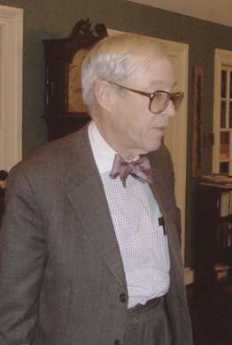
|
| Greg Harvey |
The Right Angle Club was recently fascinated to hear Greg Harvey, a Montgomery McCracken expert on election laws, discuss the snarled Florida situation in the 2000 Presidential race, and the prospects for similar problems in upcoming elections. With the aid of retrospect, candidate Al Gore deserves much of the blame for his own loss, and the U.S. Supreme Court does seem to have terminated the uproar without affecting the final result.
A consortium of major newspapers funded an extensive investigation of the Florida election and were forced to agree that George W. Bush would probably have won that election no matter what. The central issue in these contests is the 35-day time limit to contesting elections. It is true that right or wrong, the country needs to settle its elections promptly and get on with its business. Furthermore, if a national election is so close that it takes months to decide the winner, there can't be a great deal of difference between the candidates, so who cares.
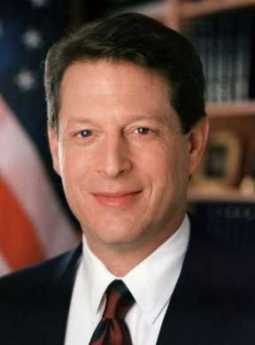
|
| Al Gore |
Looking back at the 2000 election with the leisure of time and appreciable resources, it is possible to see that Al Gore might have won that election if he had made several lucky choices in contesting its result. But it seems highly unlikely that anyone in his position would have been able to identify the winning combination of choices -- within the 35 day time allowed for pursuing them. He had to guess that ballots with two candidates marked ("over balloting") would pick up more Gore votes than ballots without an indicated choice ("under balloting"); he guessed wrong. He had to decide whether challenging late ballots from absentee military was worth the unpopularity of pursuing such a technicality to the disadvantage of soldiers serving overseas. His ticket-mate Joe Lieberman urged him to avoid that touchy issue which did prove to cost him some votes he needed. The decision was one to be proud of but is the main reason why his party faithfuls later turned rather viciously against Lieberman. A second wrong guess was to fail to go after the software mixup on invalidating the ballots of convicted felons. He might have picked up a couple of thousand votes, but only if willing to have the world learn that convicted felons are overwhelmingly pro-Democratic voters. The one decision he made that makes him look rather sappy to professional pols was to challenge ballots in the districts where he was already very popular.

|
| Vote |
Vote counters and poll watchers tend to be strong political partisans, usually drawn from the local district. When votes are ambiguous, these people lean in the direction of their party. Therefore, most party insiders would know immediately; if you challenge districts, challenge the districts which favor your opponent. Choices like this do have to be made. The thirty-five-day rule makes a challenger run out of enough time to look elsewhere if early guesses prove wrong. So, although it is possible in retrospect to construct for Gore a winning strategy for selective challenges, the newspaper consortium and the Supreme Court which pondered the choices before him rightly concluded he was destined to lose.

|
| HAVA |
Some of these lessons are enduring ones, but future elections face unexplored difficulties. A new election law (the Help America Vote Act, or "HAVA") sought to reform the election system by prohibiting the use of punch card ballots, requiring states to use auditable vote records and provisional ballots in doubtful cases, stricter voter identification methods, and statewide voter registration databases. In response to these record requirements, many states opted for complicated data in code, sequence-scrambled to prevent individual identification. In the event of a challenge, however, deciphering these records will be time-consuming, and the potential is created for the candidate who is initially ahead to stretch out the process until the challenge effort collapses at the 35-day time limit.
Several states, including Ohio, are thought to have the potential for very close 2008 results. In that particular state there are some complicated rules about voting in the "wrong" district, that is, to be registered in one district, but attempting to vote in another. It would not seem difficult to do a little of this on purpose, either as a voter, or an election registrar. It seems unlikely that very much challenge among the three possible culprits could be accomplished within thirty-five days of a contested election. So the challenger in Ohio would be faced with the same sort of impossible snap decisions that faced poor old Al Gore, surrounded by excited partisans shouting at the top of their voices.
So perhaps Greg Harvey's law school classmate Appellate Judge Richard Posner has a sustainable position on this. It was his judgment that the 2000 election was essentially a tie. Letting the Supreme Court decide it wasn't the worst possible choice.
www.Philadelphia-Reflections.com/blog/1515.htm
The Trigger and the Cliffhanger
Our own John Fulton recently told the Right Angle Club the market gossip about just who did what, and to whom, in the March 2008 beginning of the investment banking collapse. It begins to look as though Merrill Lynch had quite a bit to do with the mechanics of starting this impending market melt-down, although lots of other people helped.
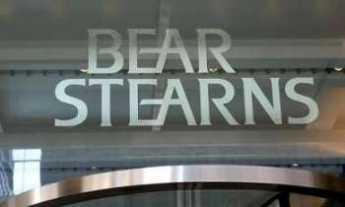
|
| Bear Stearn |
Going back to 2005, Merrill was late to the securitized debt party and stretched to catch up. The broker reportedly sold large quantities of mortgage-backed securities (CDO) to the two hedge funds run by Bear Stearns. A buyer was able to convince himself such securities might pay as much as 20% income if leveraged up -- so attractive that Merrill independently decided to keep a lot of them for its own account. Nevertheless, the primary business of any broker is to buy and resell quickly, holding as little inventory as possible. Such sales, especially to hedge funds and institutional investors, were largely on margin. When suddenly the price of CDOs started to fall -- the rumor is that some unknown European bank started unloading them -- someone at Merrill made the decision to issue a margin call, that is, ask for cash to replace the loans. Bear Stearns reportedly asked for extra time to get the money together, but Merrill was adamant. So, Bear Stearns had to sell some of the CDOs in question to raise cash, dropping the market price. (this had not been the case seven months earlier when a bewildering market saw good stocks being dumped to cover losses in bad stocks.) But remember, in addition to the securities sold to Bear Stearns, Merrill itself had acquired huge quantities of similar CDOs; the internal coordination of Merrill has to be doubted. So the market value of what Merrill held declined, too, quickly forcing Merrill to announce an $8 billion mark-to-market write-down of its holdings, eventually followed by write-downs approaching $100 billion. In time, its own losses greatly exceeded the debt it was forcing Bear Stearns to pay. Merrill had shot itself in the foot.

|
| New York Stock Exchange |
At that point, suddenly no one would write Merrill insurance against price declines through the Credit Derivative market, so it's stock price declined on the New York Stock Exchange, further reducing the amount it was allowed by regulators to lend. Because Bear Stearns was a major bookie in the Credit default swap market, both the insurers and the insurees were at risk; doubled-up "counterparty risk" was so enormous the Federal Reserve and U.S. Treasury felt they had to bail the situation out, even though other failing institutions of comparable size had been allowed to disappear. At a minimum, two parties were at risk, at worst, a whole daisy chain of companies insuring other overlapping companies multiplied the risks to much more than the loss that originally triggered the chain reaction. At $62 trillion, the Credit Derivative market is so much larger than other markets that anything to calm it seemed an urgent necessity. (As a matter of fact, when the swaps were sorted out they canceled each other by at least 90%) Every bettor had seemingly felt justified in betting the ranch, because some other bettor stood behind them, and then another and another; hard though it is to believe, that was nearly the case. Since Bear Stearns held thirty times as much debt as its total stockholder equity -- quite a different situation--, an average price drop of only three percent was enough to wipe them out. When margin calls went out to people who themselves had to issue more margin calls to pay the bill, the chain reaction did indeed bring markets to a precipice.
Until better gossip surfaces, this is the description now in circulation for the details of the slide which got going in March 2008. A larger view might be that things were starting to get ugly in 2005, and Merrill should never have entered this particular market at all.
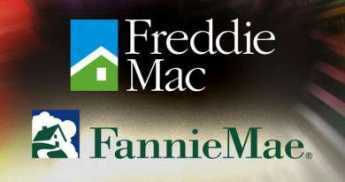
|
| Fanny Mae Freddy Mac} |
We are definitely not out of the woods. John Fulton pointed out the next crisis is that Fannie Mae and Freddy Mac are best regarded as insolvent. But since the credit crunch dried up the other half of the CDO market for mortgages, only Freddie and Fanny now remain to support housing transactions, with $5 trillion at risk in the market. That's about the size of the national debt, so when the Government assumed the risks of these two corporations, the national debt was effectively doubled. That could potentially send the dollar into a tailspin, along with U.S. Treasury bonds, while sending the price of oil skyward. So far, the Chinese have been remarkably cooperative, and Ben Bernanke and Hank Paulsen have been remarkably sure-footed.
So, what do we do if we fall into this abyss? Well, one thing debtors usually consider when threatened with insolvency is to walk away from either their debts or their creditors. In the nation's case with its debts, one major victim would be our system of entitlements. The national debt is now effectively $10 trillion. The unfunded entitlements are about $52 trillion; this is much the larger problem. Is it really true? Are we really saying these things?
John did indeed keep us awake, which is the major duty of a Right Angle speaker. .
www.Philadelphia-Reflections.com/blog/1509.htm
Turtles and Bananas

|
| Snapper Turtle |
Snapper soup, the old Philadelphia stand-by, probably got its name from snapping turtles. But for a century or two, the ingredient turtles came from the Caribbean or even further south. The huge tortoises of the Galapagos were once picked up by whalers, stored alive in the hold of the ship, to be used as needed by the sailors. Only the paws were edible. In time, the more usual imported turtle had a diameter of two feet and was picked up on South American voyages. By the end of the nineteenth century, the steamship trade was dominated by Moore-McCormack, United Fruit, and the Grace lines, who all sailed much the same kind of steamship, carrying a few passengers and a lot of cargo. Generally speaking, the cargoes going out of American East Coast ports consisted of machinery, while the cargoes coming back were bananas. If a ship carried more than twenty-five passengers it was required to have a physician on board, so passengers were either just a handful or about a hundred in number; it made for two general classes of vessel.
As a throwback to the Galapagos business of the sailing-vessel era, United Fruit would always bring home about fifty live turtles in the hold for the Waldorff in New York. It's now unclear who supplied Bookbinders and the Union League in Philadelphia, but it was apparently the same sort of arrangement: turtles came back with the bananas. It's getting hard to find snapper soup anymore; the explanation is probably mixed up with disturbances to this historical source.
www.Philadelphia-Reflections.com/blog/1481.htm
Lawn Tennis at the Cricket Club
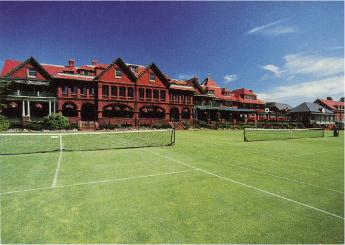
|
| Merion Cricket Club |
Lawn tennis isn't terribly ancient, having originated in England around 1880 as a variation of badminton which was brought back from India during the days of the British Empire. As the name suggests, it was originally played exclusively on grass courts, which proved hard to maintain. It was supplanted for a while by clay courts, and more recently by hard and artificial surfaces. Lawn tennis on lawns has largely become a game for the rich because of the cost and difficulty of maintaining a playable surface in hot weather.
If you wander into the Merion Cricket Club you'll find lawn tennis in the grand style, viewed from luncheon tables under a roofed porch. The long relatively narrow porch is right up against the grass courts, but it's also sort of a Peacock alley where well-groomed young ladies show their stuff, and everybody at the tables wishes to seem to know everyone else. There are times when the athletic entertainment becomes cricket out there on the field beyond the porch, but a larger proportion of the lunchers turn their backs on the field during that season than when exciting tennis championships are reaching the finals.

|
| "Lawn" Tennis |
In addition to being more expensive to maintain the courts, tennis on the grass is a different game from tennis on a hard surface, like clay or asphalt. The ball tends to skid when it hits the grass, so it is more effective to volley it before it hits or before it takes much of a bounce. The bounce tends to be more nearly straight up, while on harder surfaces the ball bounces at a low angle. Either way, the consequence is a tendency for a faster game on grass. The players run harder to get the ball at the bounce, and the advantage goes to those who serve hard and return the ball hard -- and fast.
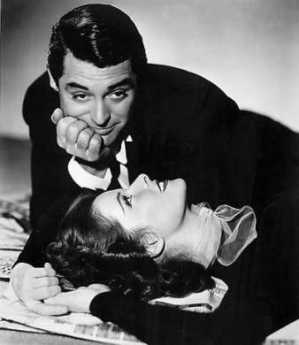
|
| Cary Grant and Kathryn Hepburn |
The rather special nature of the game adds to the up-scale atmosphere. And makes it just as attractive for the Kitty Foyles at the tables, as for the Kathryn Hepburns, both of whom have their own attractions for the Cary Grants. The parking lot is also a good place to form an opinion about the latest in high-priced autos.
www.Philadelphia-Reflections.com/blog/1494.htm
Urban Bridges

|
| Reverend Mary E. Laney |
The Reverend Mary E. Laney recently told the Right Angle Club about her experiences in an Episcopal mission church, along with the history behind this innovation, and the establishment of a 501(c)(3) organization to help the idea on a national level. That may mean no more to readers of this site than at first it probably did to the Right Angle Club, before Mary Laney made it all come alive. It was quite moving.
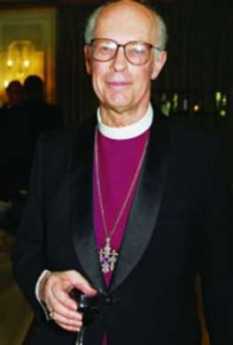
|
| Bishop Alan Bartlett |
During the 1980's she asked Bishop Alan Bartlett, at that time the Bishop of Eastern Pennsylvania for the Episcopal Church, if she might be assigned to an urban mission. As ethnic and religious population migrated around the Philadelphia landscape, quite a few Episcopal churches have been stranded in economically depressed neighborhoods, unable to afford a full-time pastor. The concept of a mission church was developed as a designation for churches that had dwindled to the point where only a handful of parishioners were left and were assigned to a category in which the Bishop would appoint a part-time Vicar to be in charge of what then needed financial support from the main church. Although in a sense Bishop White started the idea two hundred years earlier, there were no mission churches in Philadelphia in colonial times, but there are now over fifty of them, a quarter of the Episcopal churches in the region. Reverend Lancey was assigned to St. Gabriel's at the corner of Front Street and Roosevelt Boulevard, and stayed there fifteen years. She is now with St. Christopher's in Gladwynne.
The initial concept was to identify eight lead mission churches, build them up to be self-sustaining, and then replace them with eight new ones. With all good will and hard work in the world, this concept failed, largely because the social conditions of the poor at that time also depressed their educational level, and had instilled in them a culture of constant failure. In one telling episode, the parishioners said there was no hot water in the church. As a matter of fact, the pilot light of the hot water heater had gone out, and the parish was so sunken in the mindset of failure and despair they had not even looked into it. Mary Laney decided something had to be done to change the model.
What seems to have worked was the creation of a 501(c)(3) organization called Urban Bridges. The original idea behind this organization was that since the Constitutional separation of church and state precluded government grants to church no matter how struggling, but perhaps a tax exemption would make it possible for private donations to accomplish what was needed. There was, in addition, the sad experience that whenever the constitution barriers had somehow been overcome by circumvention, the many layers of bureaucracy usually consumed the money. It had proved disheartening to see four or five years go by after a government grant, with not a cent getting to the programs and all consumed by consultants, advisers and supervisors.
Meanwhile, the poor parishioners continued to base their hopes on this sort of relief, while neglecting things which might be more effective.
The Urban Bridges program evolved from a primarily fund-raising organization into a system of partnerships between prosperous suburban churches and the struggling urban missions. The suburban churches proved to be inspired with a wish to help but frustrated by a lack of means to do anything effective. It thus evolved that the suburban Episcopal churches supplied what was really most needed: practical examples of leadership on a local level, combined with visible evidence of successful effort. Literacy courses, drum and bugle instruction, computer tutoring and a variety of other spontaneous activities led to the example of leadership, and in the long run, was a far more effective fund-raising tool than printed appeals and button-holing. Even in the case of crime, it was the leadership that made the difference.
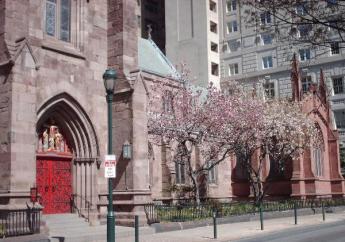
|
| St. Christopher's Church |
The story was told of a drug dealer in the neighborhood who dominated the streets with dogs and blocked access to schools unless the children agreed to sell drugs for him. Local police had proved unhelpful, and hopelessness was rampant. What would prosperous suburbanites do in such a situation? Obviously, suburbanites would not stand for such a situation and called in the Federal Drug Enforcement Agency. The crook was promptly deprived of his dogs and now resides in jail. That may not be wholly in the spirit of peaceful reasoning, but it's the American Way, all right. This was what seemed to be missing in the culture of poverty. It's the determination that whatever the cost, intolerable things will not be tolerated, combined with absolute faith that the system does provide ways to be effective without becoming either lawless or wards of the state. This is America, right?
The Corinthos Disaster
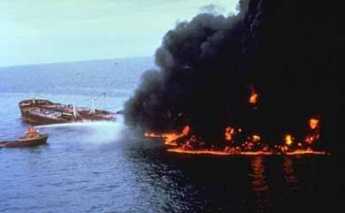
|
| Oil Tanker on Fire |
Fire, huge fire. The Corinthos disaster of January 30, 1975, was the biggest fire in Philadelphia history, and one hopes the biggest forevermore. Its immensity has possibly lessened attention for some associated issues which are nevertheless quite important, too. Like the issue of punitive damages in a lawsuit, or the need to balance environmental damage with a national need for energy independence. And the changing ways that law firms charge their clients. We hope the relatives of the victims will not be offended if the tragedy is used to illustrate these other important issues.
On that cold winter day, two big tanker ships were tied up alongside the opposite banks of the Delaware River at Marcus Hook. The Corinthos was a 754-foot tanker with a capacity of 400,000 barrels of crude oil, tied up on the Pennsylvania side at the British Petroleum dock with perhaps 300,000 barrels still in its tanks at the time of the disaster. At the same time, the 660-foot tanker Edgar M. Queen
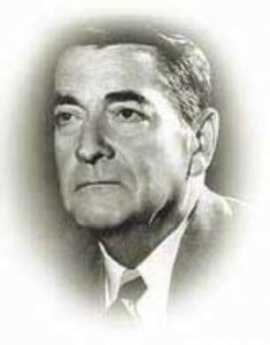
|
| Edgar M. Queeny |
with roughly 250,000 barrels of specialty chemicals in its hold, let go its moorings to the Monsanto Chemical dock directly across the river in New Jersey, intending to turn around and head upstream to discharge the rest of its cargo at the Mantua Creek Terminal near Paulsboro. Curiously, a tanker is more likely to explode when it is half empty because there is more opportunity for mixing oxygen with the combustible liquid sloshing around. A tug stood by to assist the turn, but the master of the Queeny felt there was ample room to make the turn under her own power. With no one paying particular attention to this routine maneuver, the Queeny seemed (to only casual observers) to head directly across the river, ramming straight into the side of the Corinthos. Actually, the Queeny had engaged in a number of backing and filling maneuvers, and the sailors aboard were appalled that it seemed to lack enough backing power to stop its headlong lunge at the Corinthos. There was an almost immediate explosion on the Corinthos, and luckily the Queeny broke free with only its bow badly damaged. Otherwise, the fire might have been twice as large as it proved to be with only the Corinthos burning. The explosion and fire killed twenty-five sailors and dockworkers, burned for days, devastated the neighborhood and occupied the efforts of three dozen fire companies. A graphic account of the fire and fire fighting was written by none other than Curt Weldon who was later to become Congressman from the district, but was then a volunteer fireman active in the Corinthos tragedy.
There were surprising water shortages in this fire on the river because the falling tides would take the water's edge too far away from the suction devices for the fire hoses on the shore. The tide would also rise above a gash in the side of the burning ship, floating water in and then oil up to the point where it would flow out of the ship onto the surface of the river. Oil floated two miles upstream from the burning ship and ignited a U.S. Navy destroyer which was tied up at that point. Observers in airplanes estimated the oil spill was eventually fifty miles long. All of these factors played a role in the decision whether to try to put the fire out at the dock or let it burn out; experts continue to argue which would have been better. There were always dangers the burning ship would break loose and float in unexpected directions, that the oil slick would ignite for its full length, and that storage tanks on shore would be ignited. The initial explosion had blown huge pieces of iron half a mile away, and the ground near the ship was littered with charred, dismembered pieces of flesh from the victims.
, Of course, there was a big lawsuit. When a ship is tied up at a dock it certainly feels aggrieved when another ship crosses a river and rams it. The time-honored principle of admiralty law holds that the owner of an offending ship is not liable for damages greater than the salvage value of its own hulk, which in this case might have been about $3 million. The underlying assumption is that the owner has no way of knowing what is going on thousands of miles away, no control over it, no power to respond in a useful way. Enter Richard Palmer, counsel for the Corinthos. Palmer was aware that the National Transportation Safety Board collects information about ship maintenance inspections in order to share useful information for the benefit of everyone. His inquiry revealed that the inspections of the Queeny for four years before the crash had repeatedly demonstrated that the stern engine had a damaged turbine, and was only able to drive the ship at 50% of its rated power. Why this turbine had not been repaired was now irrelevant; the owners of the ship did have relevant information and had failed to act in a timely safe fashion. The limitation of liability to the salvage value of the hulk now no longer applied if the negligence was judged relevant. The defendants, the owners of the Queeny, decided to settle. While the size of the settlement is a secret of the court, it is fair to guess that it approached the full value of the suit, which was $11 million. Mr. Palmer, by using his experience to surmise that maintenance records might be available at the Transportation Agency, and recognizing that the awareness of the owner might switch the basis for the compensation award from hulk value (of the defendant's ship) to the extent of the damage (to the plaintiff's ship), probably tripled the damage settlement.
Reflections on the extraordinary benefit to the client from a comparatively short period of work by the lawyer leads to a discussion about the proper basis for lawyers fees. Senior lawyers feel that the computer has revolutionized lawyer billing practices, and not for the better. Because it is now possible to produce itemized billing which summarizes conversations of less than a minute in duration, services for the settlement of estates can be many pages long, mostly for rather routine business. Matrimonial lawyers are entitled to charge for hours of listening to inconsequential recriminations; lawyers can bill for hours of time spent reading documents into a recording machine, or sitting wordlessly at depositions. Since the time expended can now be flawlessly measured and recorded on computers, there is little room for a client to remonstrate about their fairness. Discomfort about this system underlies much sympathy for billing for contingent fees, where the lawyer is gambling all of his expenses and effort against a generous proportion of the award if he wins the case, nothing at all if he loses. This latter system, customary in slip and fall cases and justified as permitting the poor client to have proper representation, undoubtedly promotes questionable class action suits and often leads to accepting personal liability suits which should be rejected for lack of merit. The thinking underlying personal injury firms is widely said to be: most insurance companies will settle for modest awards in cases without merit because the defense costs would be no less than that amount, and occasionally a personal liability case gets lucky and extracts a huge award.
Listen to one old-time lawyer describe how legal billing used to be. After the case was over, the lawyer and the client sat down to a discussion of what was involved in the legal work, and what it accomplished for the client. A winning case has more evident value than a losing one, provided the lawyer can effectively describe the professional skills that helped bring it about. The whole discussion is aimed at having both parties leave the discussion satisfied. To the extent that both parties actually are satisfied with the value of the services, the esteem and reputation of the legal profession are enhanced. And the lawyer is a happy and contented member of a grateful community. If he can occasionally claim a staggering fee for a brief but brilliant performance, as in the case of the explosive fire on the Corinthos -- well, more power to him.
It does not take much familiarity with oil refineries to make you realize that cargoes of crude oil are a very dangerous business. We are accustomed to hearing jeers at those who protest, "Not in my backyard", and we deplore those who would jeopardize our national security to protect a few fish and trees in the neighborhood of potential oil spills. Since we do have to import oil and we do therefore have to jeopardize a few selected neighborhoods to accomplish this vital service, the opponents are sadly destined to lose their protests. But that doesn't mean their concerns are trivial. The shipping and refining of oil are dangerous. We just have to live with it and be ready to pay for its associated costs.
Google Earth Tour of Franklin Locations
On the front page of Philadelphia Reflections is found a button which will download Google Earth, and if you follow instructions on the left column, will give you a satellite tour of every blog let on the site. At least, it will when we get it finished; it's only about half complete at present. If you are unfamiliar with this approach, we suggest you download the Earth program from the Google site and get acquainted by locating your own house, or Independence Hall, or the Vatican.
In addition, every Topic (listed in the left-hand column of the front page of Philadelphia Reflections) will contain a button which generates a tour of the geoTags of that particular Topic, providing there are three or more such tags. You will generally get the best results from tours developed by unknown authors if you turn off ALL of the layers provided in the lower section of the left-hand panel of Google Earth, although you might turn them on, one at a time if you want to enhance the effects. Generally speaking, the route of Interstate 95 seems a little out of place among the local wanderings of Ben Franklin.

|
|
Take a satellite tour of nearly every place Ben Franklin ever visited. |
You should also become familiar with KMZ files and KML files. Keyhole markup language gives instructions to Google Earth, allowing authors like Bob Florig to organize tours of a particular subject. KML files are quite large, so they get compressed to make them easier to send over the Internet. Compressed files of KML are designated KMZ, referring to Winzip the decompressor. Other decompressors will often work, too, especially Stuffit for Apple users. The extra step of decompression is a nuisance, and it is possible to have the file do things itself, to become known as a self-extracting file. Self-extracting files are often, but not always, designated as EXE files.
You are here invited to take a tour of every site Benjamin Franklin is known to have visited as if you were an interplanetary alien riding a flying saucer. Double-click the blue link to download a copy of Google Earth if you don't already have one, followed by a self-extracting KMZ file constructed by Bob Florig and used with his kind permission.
There's one other feature you should know about, called overlays. Bob took an 18th Century map of Philadelphia and substituted it for the satellite map of contemporary central Philadelphia. That lets you see Philadelphia as Franklin saw it, and by changing overlays, also allows you to see the little red-brick buildings which remain standing among the skyscrapers. Both he and I are uncertain about the copyright status of the old maps and may have to remove them if the author identifies himself and protests.
Reading Books Compared With Computer Viewing

|
| Ebooks Vs. Paper |
Old folks fumble with computers and are afraid of them, but even the younger generations brought upon the use of computers generally prefer the ease and eye comfort of books. Fortunes await entrepreneurs who first overcome the technical resistance to the coming inevitable disappearance of paper books.
Electronic books are better than paper ones, not just cheaper. They are easier to search; their contents are available to the whole world, and can even be automatically translated. For browsing and scanning, everyone prefers to browse pictures, and here the Internet offers an unbeatable price advantage; color pictures in a book are prohibitively expensive, while any child with a point-and-shoot camera can broadcast pictures of his dog to the world. Movies are coming along fast, cheap sound reproduction is already available.
In the here and now present, if you have both a paper book and an electronic version available to you, which would you choose? The answer depends on how old you are, but it also depends on the age of the book. Old classics were written for paper books, while electronic books are written to exploit plentiful colored images, sound, movies and search potential. What's so far missing is a publishing industry for electronic books, offering to take the text manuscript from an author and add all of the bells and whistles. At the moment, a technical problem holds that back: electronic books are too easy to counterfeit. The genius who invents a way to prevent electronic book piracy, in a technical way that cannot itself be pirated, would sweep all lesser objections away. The protection cannot rely on patent protection alone; just think how patents could not have protected Gutenberg right up to the present struggle. The protection of paper book printing rested and still rests, on the enormous cost of high-speed, quality, printing presses.
What follows are a few observations on the current technicalities, added in the hope that understanding the issue will make some reluctant readers less timid about it.
www.Philadelphia-Reflections.com/blog/1485.htm
Rise and Fall of Books
| ||
| The Library Company of Philadelphia |
John C. Van Horne, the current director of the Library Company of Philadelphia recently told the Right Angle Club of the history of his institution. It was an interesting description of an important evolution from Ben Franklin's original idea to what it is today: a non-circulating research library, with a focus on 18th and 19th Century books, particularly those dealing with the founding of the nation, and, African American studies. Some of Mr. Van Horne's most interesting remarks were incidental to a rather offhand analysis of the rise and decline of books. One suspects he has been thinking about this topic so long it creeps into almost anything else he says.
 |
| Join or Die snake |
Franklin devised the idea of having fifty of his friends subscribe a pool of money to purchase, originally, 375 books which they shared. The members were mainly artisans and the books were heavily concentrated in practical matters of use in their trades. In time, annual contributions were solicited for new acquisitions, and the public was invited to share the library. At present, a membership costs $200, and annual dues are $50. Somewhere along the line, someone took the famous cartoon of the snake cut into 13 pieces, and applied its motto to membership solicitations: "Join or die." For sixteen years, the Library Company was the Library of Congress, but it was also a museum of odd artifacts donated by the townsfolk, as well as the workplace where Franklin conducted his famous experiments on electricity. Moving between the second floor of Carpenters Hall to its own building on 5th Street, it next made an unfortunate move to South Broad Street after James and Phoebe Rush donated the Ridgeway Library. That building was particularly handsome, but bad guesses as to the future demographics of South Philadelphia left it stranded until modified operations finally moved to the present location on Locust Street west of 13th. More recently, it also acquired the old Cassatt mansion next door, using it to house visiting scholars in residence, and sharing some activities with the Historical Society of Pennsylvania on its eastern side.
 |
| Old Pictures of the Library Company of Philadelphia |
The notion of the Library Company as the oldest library in the country tends to generate reflections about the rise of libraries, of books, and publications in general. Prior to 1800, only a scattering of pamphlets and books were printed in America or in the world for that matter, compared with the huge flowering of books, libraries, and authorship which were to characterize the 19th Century. Education and literacy spread, encouraged by the Industrial Revolution applying its transformative power to the industry of publishing. All of this lasted about a hundred fifty years, and we now can see publishing in severe decline with an uncertain future. It's true that millions of books are still printed, and hundreds of thousands of authors are making some sort of living. But profitability is sharply declining, and competitive media are flourishing. Books will persist for quite a while, but it is obvious that unknowable upheavals are going to come. The future role of libraries is particularly questionable.
Rather than speculate about the internet and electronic media, it may be helpful to regard industries as having a normal life span which cannot be indefinitely extended by rescue efforts. No purpose would be served by hastening the decline of publishing, but things may work out better if we ask ourselves how we should best predict and accommodate its impending creative transformation.
www.Philadelphia-Reflections.com/blog/1470.htm
South Amboy Explodes
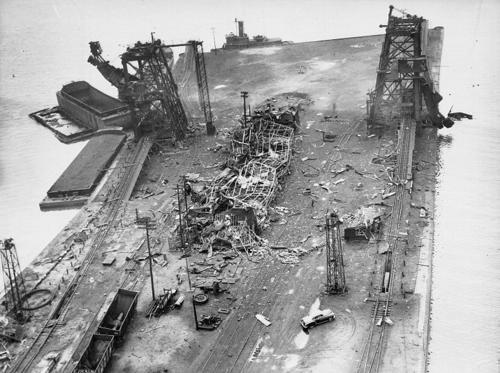
|
| Explosion |
South Amboy, New Jersey, is a waterfront industrial town on a remote promontory behind Staten Island, jutting into lower New York Bay. It's across the Raritan River from historically important Perth Amboy, but it's fair to say that few people ever heard of South Amboy until sunset on May 18, 1950, when they suddenly heard a lot. An entire freight train, five lighters, and a railroad pier suddenly exploded and disappeared. About twenty-five people were never seen again; the largest piece of metal from the explosion was only about a foot in length. A significant part of the town was leveled, steeples were knocked off churches, and windows were broken in five surrounding counties. Considering what caused it, it seems remarkable that so few people were killed. The explanation usually given is that the explosion blew straight up and straight down; the distant windows were smashed by pressure implosion.
When Pakistan split off from the rest of India, there were bloody migrations in which millions of people died. So Pakistan bought the rights to the design of certain land mines to protect its new borders and contracted with a firm in Newark, Ohio to manufacture the mines. Two trainloads of these explosives were shipped from Ohio to a railroad pier owned by the Pennsylvania Railroad in South Amboy, to be lightered out to a waiting cargo ship and sent to Pakistan. The first of these two shiploads sailed off uneventfully, and on May 1, 1950, the second shipment had already left Ohio and was underway, when the Coast Guard suddenly declared the South Amboy pier to be closed and forbidden. As the train chugged slowly eastward, frenzied negotiations took place with Admirals in Washington. There was plenty of time, because the train moved very, very slowly and it was detoured over six different railroads to Wilmington Delaware, where the Hercules Powder Company had packed two freight cars with dynamite, which were to be hooked onto the end of the train as it inched its convoluted way to South Amboy.
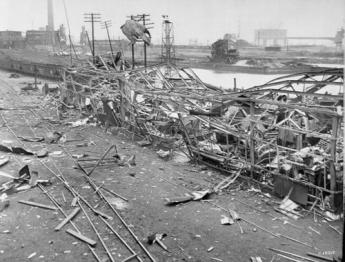
|
| South Amboy Explodes |
The method of packing the land mines was of some importance during the huge litigation which inevitably followed. Land mines were packed in cardboard boxes about six feet long, divided into six compartments. Our own Army regulations about such things state that never, never should fuse be packed in the same carton with the mines. However, this particular shipment had five mines to a carton, with the fuses in the sixth. It was later argued that this particular arrangement proved harmless in the first of the two Pakistan shipments, but there was the testimony that defective fuses were removed from those boxes and passed back up the line, where those deemed satisfactory were re-packed in the cartons which were in this, the second shipment. A fuse, by the way, does not quite describe these objects, which were screwed into a hole provided on the bomb part. They contained a spring and a steel ball in a tube; when the gadget was cocked it was held by a hare-trigger. The idea was that the pressure of stepping on the mine shot the steel ball into the ball of explosives, and boom.
The railroad ammunition pier, for some reason called The Artificial Island, consisted of two rail lines extending a quarter mile from land, but no structures. Stevedores transferred the boxes from the train to the lighters, and then five lighters took the partial shipments out to the anchorage where the ocean freighter was waiting. The deck of the lighters was lower than the train tracks, so a wooden ramp was laid from the freight car to the lighter, resting on several mattresses on deck. It all worked on the first shipment, didn't it?
Well, it didn't work this time, and we have no way of knowing who stumbled or dropped something; we only know it all went sky-high. For this, the ship-owners were delighted because it is a well-established principle of Admiralty law that unless the ship was in contact with the owners, their liability is limited to the value of the damaged vessel. Under conditions of total disintegration, that means the lighters had a liability of zero. But there were six railroads, the Pakistani government, the Coast Guard and the two manufacturers of the explosives available to sue. Everybody had insurance, so a dozen insurance companies were involved. All of the victims and hundreds of people with property damage, all had lawyers; everyone agrees that many lasting friendships were established among lawyers who were milling around. Finally, the judge declared this case just had to be settled, or else it would continue for the rest of everybody's lifetime. The total amount of the claims submitted came to $55 million. Obviously, the settlement would be for less than that, but settlements are kept secret and you are not supposed to know how it turned out.
So, the question that remained was this. If everybody was insured, why not let the insurance companies haggle about who owed what to whom. Why did all of those railroads have lawyers hanging around? Well, the answer is a lesson for all of us. You need a lawyer to watch your insurance company's lawyer, because once a claim action begins, you and your insurance company develop a conflict of interest.
www.Philadelphia-Reflections.com/blog/1482.htm
The Man Behind the Mann
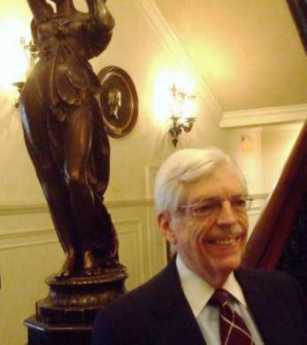
|
| William Leonard |
William Leonard, a distinguished lawyer retired from the distinguished firm of Schnader, Harrison Segal and Lewis addressed the Right Angle Club recently about his adventures running the new and improved Mann Center in Fairmount Park. A member of the board, he was suddenly asked to act as interim CEO when Peter Lane went on to another career. His task was to hold the organization together, while a permanent replacement was recruited. It turned out that directing an organization and actually running it are two entirely different things. It was necessary to learn about show business programming, the problems of rock groups, the whims of donors, the headaches associated with food vendors, and lease renewals with city governments, not to mention the rigidities of state and federal rules. Leonard obviously enjoyed the challenge, although most of us wouldn't.
The Philadelphia Orchestra had been playing summer concerts in the park since 1930, eventually adopting the name of Robin Hood Dell, East. Although the city contributed a couple hundred thousand dollars of support, and several hundred thousand other dollars came from non-ticket sales, classical music was always a long way from breaking even. The big revenue came from Rock Concerts, which may have been humiliating for the classical musicians of international fame, but was nevertheless what it took to survive, take it or leave it. Fred Mann in 1976 took the lead in raising funds for a roofed outdoor performance center, and the enormous energy of Peter Lane was brought from the New York Pops to get things going. In ten years, the Mann Center increased its outside support to $2.8 million of the $8 million annual budget and was putting on forty performances a season, with attendance increasing by 20% from 2006 to 2007. All this was accomplished in spite of the city government dropping its contribution to zero, and dropping music courses in the school system.
In a sense, the city stringencies may have been a blessing for the Mann. A second capital campaign raised $15 million for expanded facilities and parking, as well as an education center, to meet the new community need. A complimentary ticket program distributes 50,000 free tickets yearly, and seats on the lawn cost $10. If you want to get under the roof, it costs more. The free program familiarized parents with the program, and the educational center is now thriving.
Mr. Leonard brought along the new CEO, Cathy Cahill, and it looks as though he made a good choice. She's only been here for 19 days, but she went to Temple and Drexel before taking jobs out of town. She's a cellist herself, which should ease labor relations somewhat, although the pep and enthusiasm are surely innate. We hear that SEPTA is planning to re-open the R-5 station, and jitney bus service for the whole Park complex will be shared with the Please Touch Museum and other new activities in the 1876 exhibition area. There are plans for a Shakespeare repertory group to have a home here. This drive and enthusiasm are going to be necessary because Rock Groups are now competing in the Wachovia Center, and the Tweeter Center in Camden. Apparently, the secret of classical music finances leaked out.
www.Philadelphia-Reflections.com/blog/1479.htm
China Bubble

|
| Foreign Money |
China's rise to prosperity is the biggest, fastest industrial revolution in human history. Arriving two hundred years late, naturally, it has disruptive effects on the rest of the world. The Chinese want most to avoid a revolution, but also want to prolong the bonanza phase of their cycle. America must first avoid getting swamped by this tidal wave of foreign money. After that, adjust to an inevitable outcome: a more powerful China, but one with far slower growth, maybe a recession or two. Their wages must rise so our wages may rise; a future difficulty for both countries, with hyperinflation a danger. The Pacific Ocean may not prove as peaceful as we hope, but first, we must get through the Straits of Magellan.
Although the financial storms had been brewing ever since Richard Nixon visited China, the violent arrival of these issues first burst in on the American public during vacation, in the middle of sunny August, 2007.
www.Philadelphia-Reflections.com/blog/1486.htm
Federal Reserve Changes Its Business Model
Americans generally do not begrudge the success of neighbors; the achievement of someone else takes away nothing from me. In that spirit, we like to see developing countries rise up out of poverty. A more prosperous world is a safer one.
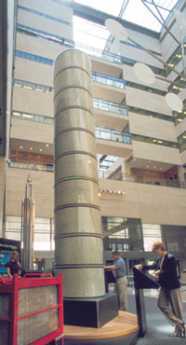
|
| Philadelphia Federal Reserve |
Rising international prosperity can, however, disrupt matters. When developing countries become producers, they can get inflation if they suddenly have more money than they know how to spend. Sudden wealth can come from discovering oil or gold or copper; slowly learning how to manufacture something is a safer way to prosper. Inflation and huge internal income disparities often lead to revolutions, so the wiser countries sterilize local money by exporting it. Coups and dictatorships are what happens if a developing country doesn't export its inflation; sudden wealth gives the appearance of being underserved. Conversely, our recent dot-com and Sunbelt real estate bubbles show what happens to the neighbors if developing-world inflation gets dumped on them. Eventually, of course, developing countries eventually balance their new production with new consumption, and the world settles down to a new balance. Never mind denouncing the rubbish the newly-rich decide to consume; its only problem for others lies in using up the world's resources faster. Developing countries commonly export inflation to other nations in the form of commodity inflation. The neighbors can soon have a commodity bubble on their hands; when any bubble bursts, a sharp recession can quickly follow, and after that, some other kind of bubble appears. What is new and disruptive is not oil or gold or copper; it is too much money.
With luck, these disruptions consequent to a neighbor's prosperity are soon overcome by improvements in productivity. But productivity itself can create a bubble. One huge productivity windfall for America is the astonishing thirty-year extension of longevity we have experienced; in time, we will surely devise occupations for retirees more productive than thirty-year vacations. Such balancing adjustments right now seem most likely to grow out of electronic productivity, using home sites as work sites.
So in short, America must read just like everyone else and one systematic readjustment has just surfaced at the Federal Reserve. The flood of money from China and the Persian Gulf sought an outlet in our economy, adopting the device of shifting American credit sources from banks to Wall Street ("securitization"). Cheap money once derived from bank deposits in local banks; since it now often originates abroad, it now must travel through the "carry" trade and similar innovative channels for foreign surpluses to get to Wall Street investment banks, which in turn distribute the money ("credit") to American businesses which can use it more productively than the developing countries can. Through securitization (turning loans into securities), Wall Street was able to make home mortgages directly, with only token involvement of local banks. Credit markets froze up because the new procedures had neglected to enlist local bankers in the process of checking the credit-worthiness of borrowers. So long as Wall Street can continue to find new sources of cheap money, this upheaval of finance is likely to be permanent because it is desired by both sides. Access to cheaper loans and access to safer investment harmonize the needs of the haves and the have-nots. Because in its haste this new development precipitated a banking crisis, there is some danger that Congress will overreact by prohibiting securitization rather than correcting its flaws. In every participant's eyes, it's cheaper and more efficient, but new efficiency threatens old inefficiencies. This one threatens the old deposit-based banking system, and since the Fed's control of the currency is based on its control over the depository banks, it threatens the Federal Reserve. That's the real driving force behind the Fed seeking control of non-traditional credit sources; that's now where the money is.
On March 16, 2008 things came to a head with the impending collapse of Bear Stearns, a Wall Street investment bank heavily involved in Credit Derivatives. There are rumors the rescue plan implemented over a weekend had actually been devised and held ready long before then. Many imperfections now surface with experience, but at least the plan had likely been explored as thoroughly as logic without direct experience ever allows. For example, the dispersal of manufacturing around the globe favored making pieces of a product and selling them to an assembler, rather than enveloping the whole process of making a product in one giant corporation. It's cheaper, that's why they do it. But the process of buying and selling pieces to other companies greatly expanded the need for short-term credit. Therefore, it was quite unexpected that Lehman Brothers, which specialized in such short-term loans, suddenly went bankrupt for lack of quick access to capital. In the panic, it is unfortunate that Lehman apparently concealed its situation from investors. There is a danger that Congress will draw the wrong moral and somehow block the globalization of manufacture.
The Federal Reserve Act was passed by Congress in 1913, and most observers believe the Fed's inexperience in 1932 repeatedly made matters worse in that formerly greatest of all bank panics. The new plan of 2009, therefore, had to step around some limitations imposed by Congress in the past, the political pressures generated by an impending presidential election, and the powerful resistance from private industries whose future was affected. The adroitness with which such a complex matter was handled over a weekend will surely become legendary, but maybe not soon. Probably because of existing legal roadblocks, three "lending facilities" were created, but a single device was at the heart of it. Instead of lending money, the Federal Reserve offered to swap securities with new non-bank managers of retail credit. The investment banks held massive security for loans which could not be sold in paralyzed markets but could be swapped or used as security for a loan, particularly if the government stood behind the innovative transactions. Wall Street in a word had plenty of wealth, but could not turn it into money fast enough to pay its bills. So sidestepping the legal constraints, instead of giving Investment firms money as a lender of last resort, the Federal Reserve swapped Treasury Bills for the "frozen" assets held as security for mortgage loans. The securities had been "caught in a loan" as the expression goes. There isn't much difference between Treasury bills and cash, or between exchanging bonds and selling them. But the new approach could be quickly and legally accomplished, and once done, the Federal Reserve was the master of investment banks. It became effectively their lender of last resort. A great deal of advance thought must have gone into devising this readjustment to the reality that over half of loans were not backed by bank deposits, but by the securitized debt of foreigners. Regulations will ensue, hearings will be held and laws passed, but the Fed has regained control of the money supply if it can manage to make this maneuver understandable by the public.
There was a moral hazard in this; the presence of a lifeguard tempts swimmers into deeper water. It was somewhat inflationary in the midst of an inflation threat. No doubt the Federal Reserve regards these negatives as prices worth paying, and they probably are. The decisive remaining issue is not whether the initial shape of this transformation is exactly correct; it surely isn't. Just as was true in 1932, what will ultimately matter most will be whether, with this altered stance, the Fed will adjust quickly and appropriately to future difficulties. And whether politicians will even permit it to do the right thing, assuming anybody then knows what the right thing might be.
www.Philadelphia-Reflections.com/blog/1465.htm
Volunteerism Needs a Business Plan
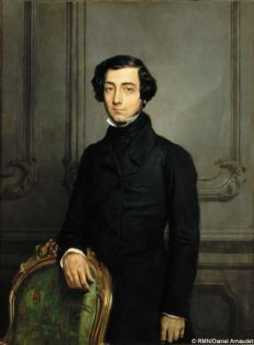
|
| Alexis de Tocqueville |
The visiting Frenchman Alexis de Tocqueville was struck most by the volunteerism he found everywhere in the young American nation; in his view, the first reaction of 19th Century Americans to a problem was to create a volunteer organization to fix it. Benjamin Franklin, who created dozens of such initiatives, was held up as its great exemplar. But de Tocqueville visited us at the beginning of the Industrial Revolution, and we are now well past that into the Information Revolution; volunteerism has noticeably declined. Not only have the great volunteer organizations like the Masons and the Red Cross suffered, but it is far more difficult to enlist the help of others to form a pick-up group to attack some issue or other. It is in that sense the general spirit of volunteerism has declined. The likely difficulty is not selfishness, but the helplessness of people to control their own time.
When volunteer groups to assemble, they are mostly composed of self-employed people like plumbers and dentists, free to be somewhere else during "normal business hours", which although shorter than they once were, seem extended by commuting time and by chores pushed aside during workplace confinement. To some extent longer commuting distances make it physically impossible to do personal chores in the vicinity of the workplace. But constrained personal time is also related to increased control behavior by management. A successful big business has to employ strategies to get employees with cell phones to stick strictly to business while the employer is paying for their time. Now that so many women are going out to work, the family unit needs to struggle to coordinate everyone's work time so there will be some remaining opportunity to conduct family life. When a working couple shares the home tasks and babysitting, the preempted time now extends to two working partners, and what is left is called "quality time". A probably temporary elaboration of this time competition is the need to chauffeur teenagers to their resume-enhancing activities. For the time being, you don't pick a college, the college picks you, and parents desperately labor to assist their children on a career path. Quite obviously, America needs to evolve better ways of trading work at home for more flexibility in the actual workplace, and we also need to build more first-rate colleges, but those issues are not the present topic. To summarize: It's awfully hard to assemble a group of volunteers simultaneously because employers have so successfully assembled their time. Failing to appreciate the tradeoffs inherent in commuting time is a secondary but still important factor, somehow related to the recent housing/schools mania.
Consequently, volunteer organizations increasingly tend to regard their chores as something you hire someone else to do if it proves impossible to dump them on someone who is retired or unemployed, or too timid to refuse. Even nominal volunteers are reluctant to step forward. This leads to recruitment lectures along the line that naturally you must sacrifice if you really truly believe in the goals of the dear old Whatsis Association, surely just a coercive speech pattern. That claptrap was never heard during the age of universal volunteers; volunteering was just one of those things everyone expected to do to get community activities accomplished. We're losing something important if we continue to endorse this attitude. Sometime during the first twenty-four hours in military service, for example, someone will surely advise the new recruit -- never volunteer.
For a penniless non-profit to adopt the solution of hiring staff when there is no revenue stream to pay them, is the first step toward the dissolution of the organization. Essentially, the non-volunteers are ordered to contribute money if they choose to be draft-evaders, and eventually, the officers and staff begin to look back at the organization members as cows to be milked. A class of people who are only making a living is substituted for those who understand and promote the goals, and it just goes downhill from there.
Instead, all volunteers really must each do some unpaid work, and the officers and directors must set an example of it. What an organization does next is crucial. Individual members, either anonymous or hoping to remain anonymous, must be approached with the suggestion they accept responsibility for a task. The wild-eyed response to this approach is quite familiar, like the lame excuse that there is no time. A counter response that I'm busier than you are, does not improve the conversation because it suggests the refuser is merely a selfish shirker. Instead, initial requests must take the following form: They should be for a simple, limited task without any obligations stretching to infinity. Almost everyone will be glad to bake a cake for a party, but almost no one will agree to be chairman of the cake-baking department unless the boundaries of that commitment are more reliably limited than they usually are.
In modern times, any major undefined volunteer responsibility is seen as potentially leading to an unthinkable conflict with gainful employment or else its ill-considered outgrowths like commuting. Since that's the basic problem, all-volunteer invitations must respect the true issue and devise workable ways to circumvent it. Role models certainly help if you have any.
www.Philadelphia-Reflections.com/blog/1448.htm
Gettysburg
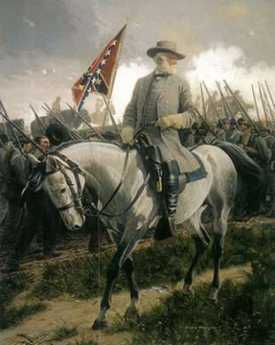
|
| General Robert E. Lee |
It's quite a long drive from Philadelphia to Gettysburg, but General Lee was attempting to disrupt supplies to the "Arsenal of the North" by capturing the railroad center at Harrisburg. Furthermore, Philadelphia reacted as if Lee's advance was aimed straight at us, creating hysterical preparations for an invasion which had to be stopped before it got here. And finally, George Gordon Meade, the Union commander, was a Philadelphia home town boy. So, regard the Battle of Gettysburg as part of Philadelphia history, please.
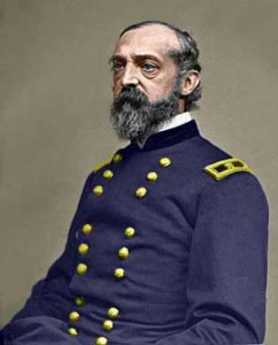
|
| General George Gordon Meade |
Major (ret.) Lawrence Swesey is a West Point graduate and currently Administrator of the 1st City Troop; because of his enthusiasm for the subject, he runs a tour agency which specializes in battlefields, especially Gettysburg. From him, the Right Angle Club recently learned much that made the whole episode comprehensible. Such as Lee's purpose in going there, which appears to have been based on the growing recognition that the South was likely to lose the war, and desperately needed some major victory in Northern territory, both to take the pressure off the Southern homeland and to improve whatever terms might be extracted at a peace negotiation. To fight successive battles against a larger enemy, with larger economic resources, was to doom the South eventually as resources and men were depleted with no hope of replacing them. Sooner or later, some Union General like Grant would settle down to a grinding unrelenting assault, with the willingness to trade one death for another, until only the larger side was left standing. That's quite different from guerilla warfare of the type Washington fought, where the way to win was simply to avoid losing until the stronger side lost its civilian support. Lee could feel the South beginning to lose its nerve to fight on indefinitely, without any visible route to victory. Although Grant eventually did defeat him by attrition, Grant's own opinion appears to have been more personalized. In every war, he was later to say, there comes a time when both sides want to quit. The side that wins is the one with a general who keeps fighting for no particular reason until the other side finally quits and he wins the war.
Major Swesey emphasizes that rifles were available, but they cost four times as much as smooth-bore muskets which were only effective for twenty or thirty yards. Rifles were reserved for sharpshooters, and the enemy at a distance was bombarded by artillery as the two sides approached. So, in Pickett's famous charge, most of the casualties took place in the last fifty yards. Pickett's men had to contend with trudging stoically through an exploding field of cannon fire, unable to fire effectively at the Union men behind a stone wall, who were also supposed to lie passively on the ground while the Confederate artillery pounded at a stationary target. Somehow, most of the Southern artillery fire went over the Union heads and landed beyond the crouching line; in many ways, this was the main factor in the Union victory.
As the waves of attackers got within musket shot of the wall, they formed into three ranks. Since it took about a minute to reload the musket, a more or less continuous fire could be maintained by rotating three successive volleys rank by rank, at more or less point blank range. Then, fix bayonets, and the real slaughter became a hand to hand, in the blazing heat of summer.
www.Philadelphia-Reflections.com/blog/1436.htm
SCORE
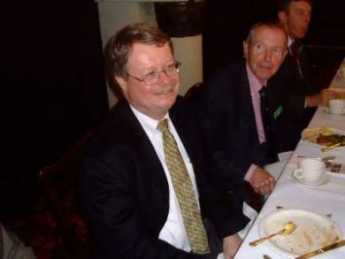
|
| Mark Maguire |
Frank Pace, formerly Secretary of the Army, founded SCORE, the Service Corps of Retired Executives, in 1964. Philadelphia was one of the main founding chapters but tended to dwindle as business large and small dwindled after the bombing of West Philadelphia by the then-Mayor; former executives living in the suburbs lost interest. In December 2006, Mark Maguire took charge and gave SCORE a new direction. This former executive of Rohm and Haas is not related to the baseball home-run king, but at least his name is easy to remember.
The new sociology of center city demanded that more small businesses be started by minority residents, who have very little family and cultural experience in this sort of activity, which nevertheless is recognized as the main source of job creation in any area. It turns out that the main source of energy in the minority community is among minority women, who are particularly unfamiliar with the problems of small business. So, SCORE needs to dispel a number of misconceptions and unrealistic ambitions, and familiarize these budding entrepreneurs with the tax and regulatory headaches ahead of them, and teach them to be watchful of common traps and obstacles, learn to cope with fair competition, and how to recognize the signs of fraud before it happens to them.
The usual vehicle for teaching these elements of commercial life is to induce the writing of a detailed business plan, which executives can criticize for lack of realism or inadequate capitalization, suggesting ways to succeed in a field that experiences 50-60% failure in the best of circumstances. Some of this requires face-to-face discussions, lectures, and required reading. But much of it can be handled with weekly email consultations, a favorite tool of Philadelphia's SCORE chapter. Much of it can be addressed by referring the client to the proper agency or service business, or bank. SCORE has a strict ethical code for its volunteers, including a prohibition of becoming a vendor or participant in the business.
In addition to the changing nature of new small businessmen, there is a changing demographic of the volunteer executives who do the advising. Over 80% of them describe themselves as retired, but in fact, it is rare for one to be totally retired from all business activity. These guys really like to work, and a thirty-year vacation is not their goal in life. Just by acting as an example, they are establishing an important goal for the young businessmen and women who look to them for guidance. Work is how you accomplish something in life, and work, believe it or not -- is fun.
www.Philadelphia-Reflections.com/blog/1430.htm
Onward, Christian Soldiers
Among the ten largest cities in the United States, Philadelphia at 24% has the highest poverty rate. Why that should be so, and what should be done to change it, are questions for another article. Meanwhile, many helpless hopeless people need immediate help with problems of daily survival. No doubt, Philadelphia's long history of practical charity has acted as a magnet for victims of social problems caused elsewhere, and many of our locals who deserve some blame have moved away to more promising environments. For those who remain and want to help the immediate need, these things don't matter, just so long perhaps as emergency measures do not interfere with long-term solutions.

|
| Salvation Sign |
Among many private relief efforts, the Salvation Army is widely acknowledged to be the most efficient and most effective, as well the largest. Before the big event in 2004, it had a $3 billion budget and 3 million volunteers; an army, indeed. Except for Quaker charities, which mean to spend nothing on solicitation except through their own example, the Army spends a notable record of 91% of its budget for direct relief. In Philadelphia, they have 9 community centers, 8 residential centers, and 2 children's shelters. This is the largest charity in the United States, with branches in 110 other countries. There are 65,000 homeless people sheltered, every night.
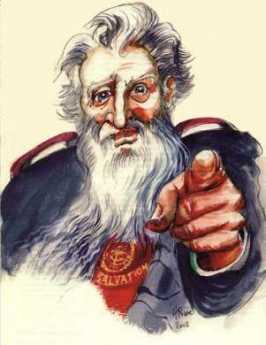
|
| William Booth |
A moment should be spent on the history of the Army. It was founded by William Booth, who was a London pawnbroker before he became a Methodist minister. Sir Arthur Sullivan wrote "Onward, Christian Soldiers" in 1871 a decade before it became so aptly associated with the Salvation Army, and indeed before it became attached to the words of Sabine Baring-Gould . Originally the music had to do with St. Gertrude. The militarism of the organization has offended some people, even elders of the Methodist Church, and the Christian emphasis offends non-Christians. United, or Community, Funds are miffed that the Army usually will not agree to limit its solicitations to their umbrella, and modern sophisticates scorn the 19th Century traditions of Christmas Kettles, and such like. Since the main emphasis of the Army has been on relieving the problems of the Industrial Revolution, like alcoholism, drug addiction, prostitution, some see an implied criticism of modern progress, or of capitalism, or the entertainment business in general. Some people don't like the fact that most of the causes of poverty could be described as self-inflicted. You simply can't satisfy everybody. But when the rehabilitation of alcoholism and drug addiction generally carries a success rate of 25%, the Salvation Army approach -- no matter what you may think of its symbols -- is able to defend the claim of 65% success. If you don't like "Human Needs in Jesus' Name", just try "Practical Success in a Difficult Field" for a subtitle.
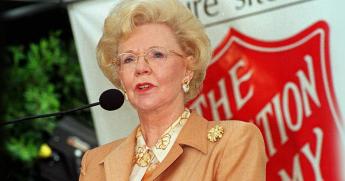
|
| Joan Kroc |
It thus becomes understandable that when in 2004 Joan Kroc, the widow of the founder of McDonalds Hamburger chain, decided to leave her estate of $1.5 billion to relief of the poor, she chose the Salvation Army to run things for her. Her interesting will divide the country into four parts, with 28 cities to receive $36 million grants for the construction of community centers, plus an equal amount for the endowment to run them. The size of the grants was calculated to force the local cities to match them (Philadelphia still has $20 million to go) and the endowments specify no income to be derived if the amount falls below the original $36 million, or otherwise to be limited to a 5% spending rule. She was perhaps optimistic that investment advisors could regularly produce a 17% return, and really truly optimistic if she believed our government could restrain inflation within those bounds. But a sharp business mind shines through these covenants, a very necessary ingredient of successful philanthropy.
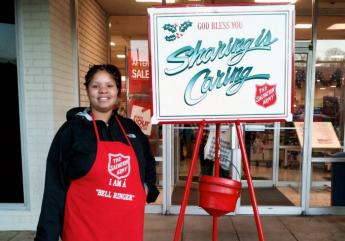
|
| Salvation Workers |
Mrs. Kroc wanted these centers to be located in the areas of worst need; that explains the choice of a 12-acre plot in Nicetown, at the corner of Wissahickon and Hunting Park Avenues. The area now surrounding a former factory for the Budd Company has a 35% poverty rate. But after 2009 it will have an aquatic center of several swimming pools, gyms and fitness centers, a computer laboratory, arts and performing theater centers, and other more traditional Salvation Army facilities. It will also have 27 other American cities with comparable centers to share experiences with, to compete against, and to be put to shame by Philadelphia's superior ideas. We hope.
www.Philadelphia-Reflections.com/blog/1425.htm
Galapagos As an Environmental Laboratory

|
| Galapagos Islands |
The Galapagos islands are on the equator, so the sun comes up at 6 AM and sets at 6PM, every day of the year. There are storms and changes in the currents, but this place comes as close as anywhere to being a constant-weather environment, useful for observing more complex places by comparison. That's part of the scientific method -- limit the variability under study. Jack Nixon just took an extended vacation there, and told the Right Angle Club about it, with slides.
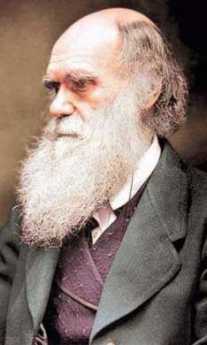
|
| Charles Darwin |
Charles Darwin, the guides relate, didn't spend much time there, and investigated very little, possibly because he suffered from incapacitating migraine all his life. He took home a collection of 13 dead finches, which after the study were from different species with subtle differences, and led Darwin to develop his theory and write his book about the origin of species. Although some people will never forgive him for upsetting the conventional view of things, it may help to know that he was a disciple of the Scottish philosopher Hume. Hume was an important factor in the American Revolution, with particular influence on Princeton and hence Scotch Irish settlers in America. Hume taught that philosophy and religion are best advanced by demanding proof that anything in nature has a purpose, because most things don't. There's a difference between having a purpose and having a utility. To Darwin, the small differences between species must have some utility to endure, and those with most utility survived better than others.
The Galapagos are volcanic peaks sticking up out of the Pacific Ocean about six hundred miles from Ecuador, to whom they now belong. They have experienced a number of small eruptions, even in the past twenty years. When the bare rock cools, birds rest on it, deposit what is delicately called guano, start vegetation, allow migrant fish and animals to survive. The islands, geologically speaking, are comparatively young, started fresh and new, and have the world's most constant climate. Many of the animal species are unique to the place, and traces of how they got to be what they now are like, still persist.

|
| Big Dodo Bird |
Along came two waves of predatory human beings. The pirates and whalers in the first wave dumped the big tortoises into the hold of their ships as fresh meat, more or less preserved. The great big dodo birds had no wings, so they were easy to catch, delicious to fry; and like the tortoises, were comparatively easy to carry along as shipboard supplies. The dodo is extinct, the tortoises almost so. However, most tourists quickly observe that tortoises spend most of their waking hours making love, so perhaps their survival can be traced to that.
The second wave of human predators were the local South American fishermen, who brought along goats and rats to devastate the fragile environment. Ecuador prizes its tourist revenue, so it has made a nearly-successful effort to eradicate goats and rats. Furthermore, immigrants are strongly discouraged; prove you have to be here or get out. Even Bill Gates had trouble getting permission to dock his yacht.
This is a place to see lots of funny birds. Blue-footed boobies, frigate birds, flamingos, cormorants, pilot whales, tropical penguins, porpoises, and albatross. The albatross keeps flying all the time, and only lands in order to mate. There's some sort of recurring theme, here.
www.Philadelphia-Reflections.com/blog/1419.htm
Camden Riversharks

|
| Camden RiverSharks |
Just about the cutest baseball park anywhere is Campbell's Field, best seen out the windows of the PATCO highspeed train as it crosses over the Ben Franklin Bridge into New Jersey. It's a regulation-size playing field with gleaming green grass, but comparatively small seating capacity. It's a great novelty to sit in the front row and have the umpire come over to chat, or to scold one of the players for spitting chewing tobacco. As told by Joel Seiden to the Right Angle Club, the performances of the home team Camden Riversharks is more about serious entertainment than serious baseball. On certain nights, there are fireworks, and free strawberry sundaes, and comedy. The finger food is cheap by professional sports standards, so it's a great place for dads to take their Little Leaguer sons.
About three-quarters of the audience usually come from New Jersey, and that's where team loyalty centers. There is hope that when the tramway to Pennsylvania finally gets built, or possibly the gambling casinos, more traffic will come over from Philadelphia. The greatest advertising comes from ordinary commuters, looking down from the bridge on a summer evening. A typical audience will be 3700 fans, rising to about 6000 on weekends.

|
| Campbell Field |
Although Campbell Field has a band-box new sparkle to it, it's had something of a bumpy financial history. It was built by Steve Schilling for $20 million with a promise to support yearly losses up to a million dollars annually. Unfortunately, he died young, leaving a will that prohibited further support, and sort of a tangled financial structure. As part of an effort to stimulate a Camden renewal, the Delaware River Port Authority loaned $8.5 million, Rutgers Camden owns the field, and Sovereign Bank put up a mortgage. Investor groups have expressed interest, Sovereign Bank has threatened foreclosure, and wrangles which have very little to do with baseball have dominated the private affairs of the team.
Because of the exemptions from antitrust which are exclusively available to organized baseball, no minor league team affiliated with a major league team may play within fifty miles of a major league team. Therefore, the Riversharks are an unaffiliated team, playing in the Atlantic League of Independents. However, this creates a source of revenue from selling promising players to major league scouts (Price: $5000). Since there is a top salary limit for players of $3000 a month, most players have a second job. They are professionals, but not exclusively professional. About 7 players are bought every year.
So, everybody involved struggles just a bit, but it adds to the gossip and buzz. So, take a trip on the PATCO train to the City Hall Station and walk three blocks, or take it to the Broadway Station and then the Riverline down to the field. Lots of fun.
www.Philadelphia-Reflections.com/blog/1416.htm
Second Amendment: The 28th Infantry Division
SINCE the nation was only formed in 1776, and the only memorable war before that was the French and Indian War of 1754, the origin in 1747 of the Pennsylvania 28th Division of Infantry needs a little explaining. The 28th is a National Guard reserve unit, taking its present organizational form 138 years ago. Even counting from that moment makes it the oldest (and third largest) division in the Army, but another 123 years of history stretch back before that.
 AMENDMENT II A well-regulated militia, being necessary to the security of a free state, the right of the people to keep and bear arms, shall not be infringed. 
|
| Second Amendment |
A few people remember that Ben Franklin made his first step into politics during King George's War (1744-48), when French and Spanish privateers were suddenly roaming Delaware Bay . The pacifist Quaker government hesitated in confusion, so Franklin stepped forward to call for a volunteer militia. It was paid for with a lottery because the Quaker legislature resisted; there seemingly was no end to Franklin's ingenuity. The unit remained a permanent one, and since then served with distinction in the various conflicts through the Civil War, when it was organized into the National Guard. The volunteer movement it inspired was part of the impetus for the Second Amendment to the Constitution which the National Rifle Association will be glad to explain to you, although historians commonly trace the civilian soldier tradition back to King James and the English Civil War. Franklin was unfailingly patriotic, and never hesitated about military measures when they seemed necessary. He lived long enough so his military sympathies were still a dominant force at the Constitutional Convention, more than forty years later.
Major General Wesley E. Craig Jr., former commander of the Division, was kind enough to address the Right Angle Club about the 28th Division recently. Since the citizen soldiers of the National Guard all have other careers, his daytime job was as an executive for Strawbridge and Clothier. A moment of reflection about the Scottish origin of his own name, connected with a strongly Quaker firm, evokes the two strongest social and ethnic tensions of early Pennsylvania history.
The audience was treated to a description of the military history of the unit, whose largest battle was the Battle of the Bulge in World War II. But they are in Iraq today, with almost every soldier having served one tour of duty, many of them two or even more. They were the unit stationed in El Ambar province during the period before the Sheiks finally decided that America was going to win this war, and changed sides. General Craig had returned to America only a month before this famous turning-point. Before that, units of the 28th were in Bosnia and Kosovo, and are proud to have been chosen for the introduction of many innovative technologies. They are the only reserve division with Stryker vehicles, and before that employed unmanned drone aircraft for reconnaissance. Observer drones fly at 2000 feet and carry no weapons, unlike the Predator drones which carry rockets and fly at 10,000 feet.
Not everything is a story of combat action; the 28th Division is very proud of its activities in the Katrina rescue missions and other domestic emergencies. The Go Ahead Division is proud of its reputation for being on time, every time.
And it is mindful of the sad side. In Iraq, it is 31 KIA, with 167 WIA. If you're uncertain what that means, try a little harder.
Burlington County, NJ
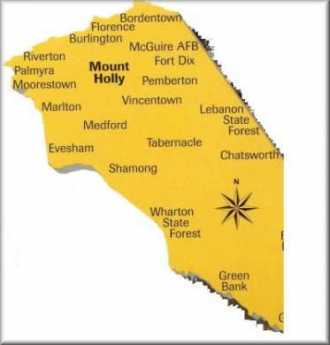
|
| Burlington County Map |
Burlington County used to be called Bridlington. It contains Burlington City, formerly the capital of West Jersey, which is how they styled the southern half of the colony, the part controlled by William Penn. In colonial times, the developed part of New Jersey was a strip along the Raritan River extending from Perth Amboy, the capital of East Jersey, to Burlington. To the north of the fertile Raritan strip, extended the hills and wilderness mountains; to the south extended the Pine Barrens loamy wilderness. The Raritan strip was predominantly Tory in sentiment, while the remaining 90% of the colony consisted of backwoods Dutch farmers to the north, and hard-scrabble "Pineys" to the south, except for the developments farmed by Quakers. The Quakers had ambiguous sentiments during the Revolution, leaving conflicts between pacifism and self-defense to individual discretion. The real fighting mostly went on between the Episcopalian Tories and the Scottish-Presbyterian rebels, both of which were sort of newcomer nuisances in the minds of the Quakers. The warfare was bitter, with the Tories determined to hang the rebels, and the rebels determined to evict or inflict genocide on the loyalists. Standing aside from such blood-letting of course inevitably led to a loss of Quaker political leadership. When East and West Jersey were consolidated by Queen Anne into New Jersey in 1702, the main reason was ungovernability, with animosities which endure to the present time in the submerged form. Benjamin Franklin's son William was appointed Governor through his father's nepotism, but when he turned into a rebel-hanging Tory, his father extended his bitterness about it into a hatred of all Tories. The later effect of this was felt at the Treaty of Paris, where Ben Franklin would not hear of leniency for loyalists, striking out any hint of reparations for their property losses. In a peculiar way, the factionalism resurfaced at the time of the Civil War, where the slave-owning Dutch in the North came into conflict with the slave-hating Quakers in the South. The problem would have been much worse if the Jersey slaveholders had been contiguous with the Confederacy, but it was still bad enough to perpetuate local sectionalism. A few decades ago, it was actually on the ballot that Southern Jersey wanted permission to secede.
Under the circumstances, when James K. Wujcik wanted to work for progress in his native area, he avoided any ambition to enter State politics and concentrated his efforts on Burlington County. He is now a member of the Board of Chosen Freeholders of Burlington County, along with four other vigorous local citizens. Most notable among them is William Haines, the largest landholder by far in the area, whose family still controls the shares of the Quaker Proprietorship. Membership on the Burlington County Board of Freeholders is a part-time job, so Mr. Wujcik is also president of the Sovereign Bank. We are indebted to him for a fine talk to the Right Angle Club avoiding, with evident discomfort, many mentions of state politics or sociology.
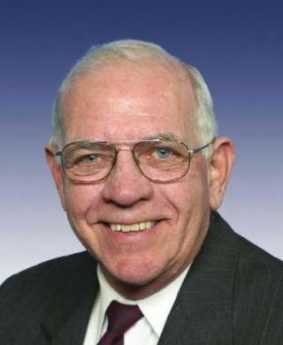
|
| Congressman Saxton |
Burlington is the only New Jersey county which stretches from the Delaware River to the Atlantic Ocean, including the Pine Barrens occupying 80% of the land mass in the center; fishing and resorts dominate near the ocean and former industrial areas along the river. Much of the area has been converted to agriculture for the Garden State, but about 10% is included in a National Preserve. The population has doubled in the past fifty years, so urbanization is replacing agriculture, which had earlier displaced wilderness. The county includes Fort Dix and Maguire Air Force Base, strenuously promoted for decades by now-retired Congressman James Saxton.
Somewhere in the past few decades, Burlington became quite activist. Although many tend to think of real estate planning as urban planning, this largely rural county went in for planning in a big way, deciding what it was and what it wanted to be. Generally speaking, its decision was to replace urban sprawl with cluster promotion. The farmers didn't like an invasion by McMansions or industries, while the towns lost their vigor through tax avoidance behavior of the commuter residents. Overall, the decision was to push urban development along the river in clusters surrounding the declining river towns, while pushing exurban development closer to logical commuting centers, leaving the open spaces to farmers. Incentives were preferred to compulsion, with a determination never to use eminent domain except for matters of public safety. To implement these goals, two referenda were passed with 70% majorities to create special taxes for a development fund, which bought the development rights from the farmers and -- with political magic -- re-clustered them around the river towns. The farmers loved it, the environmentalists loved it, and the towns began to revive. The success of this effort rested on the realization that exurbanites and farmers didn't really want to live near each other, and only did so because developers were looking for cheap land. Many other rural counties near cities -- Chester and Bucks Counties in Pennsylvania, for example -- need to learn this lesson about how to stop local political warfare. Corporation executives don't want to live next to pig farms, but pig farmers are quite right that they were living there, first. When this friction seeps into the local school system, class warfare can get pretty ugly.

|
| Burlington Bristol Bridge |
In Burlington County, they thought big. The central project was to push through the legislature a billion-dollar project to restore the Riverline light rail to the river towns, along the tracks of the once pre-eminent Camden and Amboy Rail Road. It was an unexpected success. During the first six months of operation, ridership achieved a level twice as large as was projected as a ten-year goal. Along this strip of the Route 206 corridor, the old Roebling Steel Works are becoming the Roebling Superfund Site, now trying to attract industrial developers. The Haines Industrial Site originally envisioned as a food distribution center was sold to private developers who have created 5000 jobs in the area. Commerce Park beside the Burlington Bristol Bridge is coming along, as are the Shoppes of Riverton and Old York Village in Chesterfield Township. As Waste Management cleans up the site of the old Morrisville Steel plant across the Delaware River, a moderate-sized development project is becoming an interstate regional one.
No doubt there will be bumps in these roads; the decline of real estate prices nationally is a threat on the horizon, because it provokes a flight of mortgage credit. It works the other way, too, as banks decide to deleverage by reducing outstanding loans; this is the way downward spirals reinforce themselves. And anyone who knows anything about all state legislatures will be skeptical about political cooperation in a state as tumultuous as New Jersey. The Pennsylvania Railroad destroyed the promise of this state once; some other local interest could do it again. Nevertheless, right now Burlington County looks like a real winner, primarily because of effective leadership.
Beaux Revival

|
| Cecilia Beaux |
Cecilia Beaux's mother died two weeks after she was born. Cecilia rejected many offers of marriage, was never brushed by scandal, devoted her life almost entirely to the pursuit of excellence as a portraitist of women and children. It does not take much of an amateur psychoanalyst to surmise she was dominated by fear of pregnancy, and possibly guilt about being the cause of her mother's death. But living in the Victorian era before Lister and Pasteur could finally make childbirth safe, her sort of life was not as unusual as it is today, except for her notable thirst for achievement. An aristocratic upbringing almost certainly contained a strong condemnation of boasting and self-promotion, with the result that she is sometimes referred to as a perfect model for the graduates of Bryn Mawr College, although she did not attend there. Placing its emphasis on success for women other than or in addition to marriage, the quiet determined graduates of that college make a goal of achievement, not fame. Beaux became the finest woman portraitist in America, possibly the finest portraitist anywhere, but it was a title she earned and deserved without theatrics or egotism. Lots of eligible men found this attractive, but she retreated for her own reasons in her own graceful way.
Monica Zimmerman lectures on this and other topics at the Academy of Fine Arts and recently talked at the Right Angle Club. We are grateful to her for pointing out the influence of John Singer Sargent in opening up for Beaux the borders of grand manner portraiture, enhancing the mood and intimacy by surrounding the subject with an environment, rather than the dark gloomy plain backgrounds that are so traditional. Parenthetically, there is a marvelous example of this school of portraiture hanging in the hall of presidential portraits at the Union League. Among the collection of gloomy dark backgrounds for the other presidents, the portrait of George Herbert Walker Bush shows him on the portico of the White House and allows his luminous likeableness to shine out among the severe and stately presidential peers. Photographic portraiture has to struggle to blot out distracting background; portrait photographers like Bachrach struggle to imitate what is more natural for backgrounds in painted portraits. Except for those of the school of Cecelia Beaux.

|
|
Beaux's two-year-old niece and favorite model, Ernesta Drinker (1892-1981) |
One other feature to be noticed about the Beaux exhibit is her outstanding ability to work with white. There are white gowns, white frilly dresses, white upholstery in a profusion seen rarely because it is so difficult to do.
Go see the next exhibit of her work at the Pennsylvania Academy. It's an event that will be talked about for a long time.
www.Philadelphia-Reflections.com/blog/1374.htm
Commercial Academic Think Tank
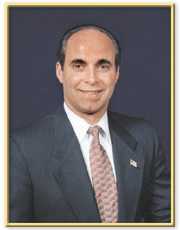
|
| Stephen P. Mullin |
Stephen P. Mullin recently addressed the Right Angle Club of Philadelphia about assorted economic subjects; he is certainly qualified. He was once the only Republican in Mayor Rendell's cabinet, acting first as Finance Director and then as Commerce Director. At first, he doesn't appear extroverted enough to be a politician but quickly demonstrated that he knew the first names of more of the members of the club than the president did, so maybe he does have the innate talents of a politician. Urban political machines don't usually respond cordially to graduates of Exeter and the Wharton School of the University of Pennsylvania. A number of University professors are consultants to the firm, which offers statistical economic advice to the many law firms in town, to philanthropic organizations considering public-interest projects in the region, to government agencies faced with regulating unfamiliar activities, and very likely to anyone else willing to pay for the service of academics, statisticians and analysts. It certainly sounds like a service that governments and philanthropies need, and which the region needs to avail itself of. In a way, it is probably something the University needs, as well. A friend of mine is now retired, but at one time I commuted on the train with an academic administrator of the Wharton School, who was quite obviously disturbed by handing diplomas to students who promptly took jobs which paid those graduates more than he was paid himself. Obviously, such a system cannot persist very long without creating a brain drain, so income supplementation by commercial consulting is a necessary and valuable support for academics. There are, of course, probably some negative features as well.
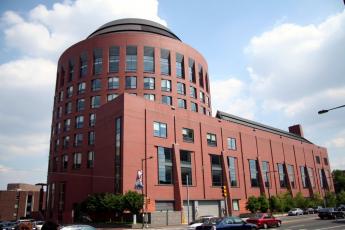
|
| The Wharton School |
It is interesting to hear from Steve how Philadelphia can be variously described. We have, for example, significantly less foreign immigration than other cities. New York, by contrast, has net immigration of about 700,000 persons a year; such forces can quickly transform a city in a variety of ways. The bombing of West Philadelphia during the Goode Administration was news for a while, then vanished from the papers. But it had a shattering effect on Philadelphia commerce, leading to a period of 8 or 9 years when there was essentially no private investment in the city. Philadelphia indeed now needs to have its municipal bonds issued by the state bonding authority, because our own bond rating is so low the extra cost of municipal debt is a significant one. And there is the cost of invisible shifting of power to Harrisburg. An unexpected result is that sales and real estate transfer taxes escalated to make up for property taxes which they could not possibly be raised as much as inflation. Real estate was in big trouble; whether ingenious strategies like the 10-year tax abatement for a new property will be successful in rescuing the real estate industry, remains to be seen. New office towers have been built, but they drain off tenants from older office buildings. We're seeing a massive conversion of older office space into residential apartments, an apparently successful maneuver. But that drains the older residential areas, which leads to -- well, who knows what it will lead to, but it could be slums.
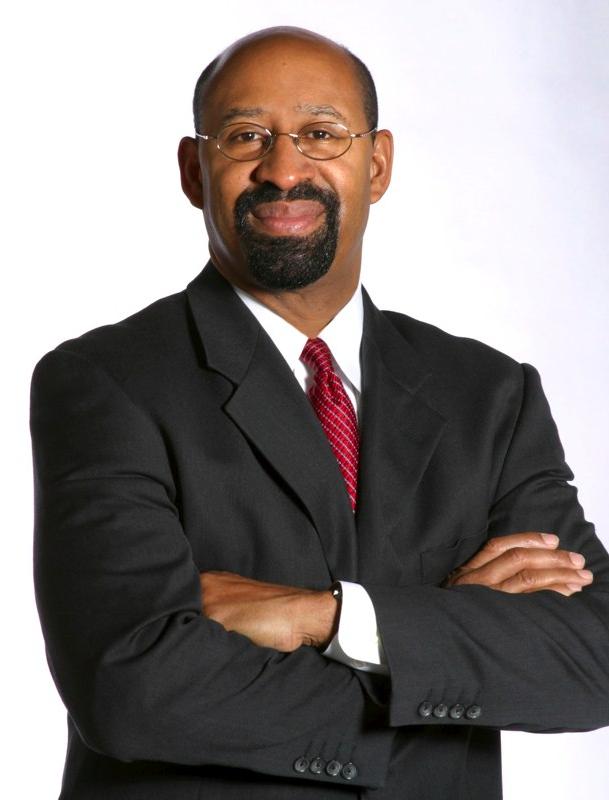
|
| Mayor Michael Nutter |
The traditional hostilities between Philadelphia and its neighbors can be defined in a new way, too. For a century, Philadelphia contributed more tax money to the rest of the state than it received in state services. But in the past 20 years, Philadelphia city has become a net importer of an annual billion dollars -- from the rest of the state. Two or three billion go to the schools, which the rest of the state regards as a deplorable waste in view of the quality of the product. And yet, the most hopeful feature of the situation is the vigor and ingenuity of the attempts being made to rescue the situation. In a certain sense, Mayor Nutter is the candidate of the Wharton School. He may well have some innovative ideas, and academic places like the Wharton School will surely suggest others. It remains to be seen whether Nutter can combine idealism with sufficient ruthlessness to make the city function. Cynical oldtimers will grumble that a mayor has to employ a moderate amount of deception and corruption in order to accomplish his mission. Maybe that overstates things, but it is very certain he must be tough. He's dealing with construction unions who will certainly be tough, and whose interest in sacrificing their own agendas in order to help the schools or street crime -- always fairly small -- is even further impaired by the econometrics that 70% of them live in the suburbs. We wish our new mayor all the best, since he seems smart enough to know what needs to be done, and is definitely smart enough not to drop any bombs on houses. He's smart enough to see that extra city revenue derived from gambling might permit the lowering of wage taxes, and hence an urban business recovery. But is he tenacious enough to stay in office long enough to achieve the balanced result; or will the forces of evil simply kick him out of office before wage taxes can be lowered and gambling discontinued? He won't break his promises, but will they break them for him? Beyond being competent, a city mayor needs to be tougher than the convivial but very mean friends he needs to associate with. He must, for example, decline to run for national office, the traditional way that city machines rid themselves of pointy-headed reformers.
Report Identity Theft to the Secret Service
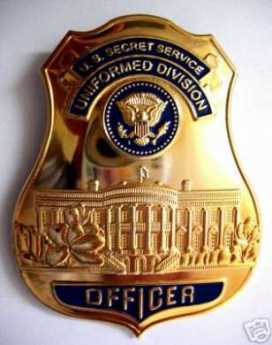
The Internet provides new blessings, but new problems as well. Identity theft has now ballooned from a rarity to a fairly serious issue. After initial turf confusion, the issue has been assigned to the U.S. Secret Service. If it happens to you, that's where you make your anguished call. (1-877-ID-THEFT) or www.consumer.gov/idtheft
There's a certain logic to regarding identity theft as a modern form of counterfeiting, which has been with us since the days of William Penn. Shirley Vaias, representing the Philadelphia regional Secret Service, recently addressed The Right Angle Club of Philadelphia on the topic. It makes sense to learn the Service is headquartered on Independence Mall, across from the Mint. The crude forms of printing in the 18th Century made counterfeiting easy, and ever since the early days, there's been a race between improvements in technology and improvement in counterfeiting. We now have a paper with little red fibers in it, watermarks, serial numbers, color-shifting inks, microprinting of secret messages in the portraits, special magnetic strips, and probably lots of other clever things we aren't told about. The Bureau of Printing and Engraving is changing the currency, one bill at a time, and recently there was a new ten-dollar bill. A counterfeit version was in circulation within six hours.
ATM machines are equipped with counterfeit-recognition devices, and special gadgets are provided for banks and retail stores, but one detection device traditionally catches most fake bills. After handling huge amounts of currency, bank tellers catch a counterfeit just by the feel of the paper. Color photocopiers are getting better and cheaper, but of course, they can't change the serial numbers, so they aren't as smart as they seem. About one-hundredth of one percent of the currency in circulation appears to be fake, so you are pretty safe, but the possessor of a bad bill is deemed to be the one out of luck. The consequence is that many citizens suspect a bad bill, take it to a bank and have it instantly confiscated without recourse. That would seem to discourage reporting a counterfeit, encourage passing it off to an unsuspecting friend, and overall seems terribly unfair; but it results from the wisdom of the ages. Experience shows honest citizens are indeed tempted to try to pass the money on. While the banks don't enjoy being policemen, the effect is that counterfeits will circulate until they hit a bank, and thus confiscation is fairly comprehensive.
As the printing of money gets more complicated, the special presses needed to produce good money has become a monopoly of certain German companies, who sell the machines to other countries. Some of the American presses thus got into the hands of some Russians, who sold them to the North Koreans. So for a while at least, the North Korean government was printing American currency. It provoked vigorous countermeasures, the nature of which is confidential.
A bill of any denomination costs the government about half a cent to produce and lasts about four years in circulation. When tons of old bills are retired from circulation, the serial numbers are recycled; to an outsider, that sounds like an impossibly tedious job, but they say they do it. There's also the issue of seignorage, a term for the profit the government makes when the paper currency gets destroyed in one way or another, costing less than a cent to replace. Just how profitable the currency business is, cannot be accurately determined, because a lot of it is buried or hidden in mattresses and might someday resurface. But there is a substantial profit, which like any shrewd businessman, the government weighs against the cost of detection. Bail bonds and casinos are big sources of bad money, as could be readily imagined, and hence it is in their interest to get pretty sophisticated (and extremely unpleasant) about detection. On balance, however, it can be expected that legalized gambling in Philadelphia will promote more counterfeiting in the local economy, and hence is an offsetting cost of the tax revenue.
Over the centuries, governments have learned how to cope with counterfeiting, and there is actually much less of it than a century ago. You win some and you lose some; life just goes on. With internet identity theft, however, the criminals are developing techniques faster than governments have learned to combat them, and it is governments who struggle to catch up. Unfortunately, everybody takes a business-like approach to the matter, asking whether the precautions cost more or less than the losses. It would seem that if money continues its migration from paper currency to bookkeeping entries, it will eventually seem unsatisfactory for only one party in a transaction, a bank let us say, to keep the books while the public simply trusts them. Eventually, each individual will be forced to seek the protection of some sort of computerized system keeping the counter-parties honest, on behalf of the public, and to prevent a paralysis of commerce. Identity theft is getting expensive enough to warrant the effort.
Just how to do all that is not too clear. So, in the meantime, just let the Secret Service figure it out.
Detroit Makes, Philadelphia Takes

|
| Junk Yard |
Let's look at the economics of a junkyard in a business-school way. Derelict auto bodies worth $80 a ton at current prices can be profitably converted into $235 worth of scrap metal, provided the cost of doing so can be kept below $155 a ton. The Camden Iron and Metal company are able to do so for $115 in expenses, and so reaps a profit of $40 a ton. That's not to mention the relief the owner of a useless car feels when the derelict hulk is taken off his hands, or the relief the City feels in ridding itself of thousands of vehicles abandoned in various alleys and public places. Or the worth to the steel mills of being able to produce new metal at a reduced price compared with starting with iron ore and limestone. Or the benefit to our balance of trade from being able to export the motor blocks and transmissions salvaged intact from the wrecks, leading to foreign motor cars of a quality that may, or may not, withstand impartial examination..
Camden Iron and Metal, Inc. is crawling with engineers who help cope with the currently dwindling steel content of contemporary autos, and the consequent increase in non-ferrous metals, glass, plastic and whatever. The most profitable component of the salvage company thus lies in a subsidiary, Innovative Recycling Products, Inc. The copper content of scrap used to be a headache, but is now a revenue center, for example. There once was a time when scrap iron was chopped up and buried in landfills. Nowadays, people are getting rich digging up such landfills and mining the scrap metal. There are other problems you probably wouldn't imagine, such as the disagreeable discovery that lots of those crushed auto bodies have dead dogs locked in their trunks.
It's big business, where a single crane, of which this company has a great many, costs $1 million, and the grinding mills and purifiers cost much more, last only a year, and must be maintained or replaced. There is an increasing plastic content in cars, so that stuff is ground up, pulverized, and burned to produce energy to run the shredding operation. Trucks bringing in a scrap for processing typically run all night on the highways, which reduces the public profile of the salvage operation but increases its 24-hour efficiency. When metal is torn apart, internal friction creates 2000 degree heat, cooled by water, producing huge clouds of steam. The closing of the Bessemer Steel Works reduced the local market for scrap steel, prompting more exports of scrap, and stimulating more search for ways to salvage other ingredients of the scrap. Increasingly, the purification of the raw material has thrust the scrap processors into the role of a pre-processing step in the steel industry. Just as slaughterhouses used to boast of using all of the pig except the squeal, hardly anything is now left of the bodies of discarded autos except for the unattractive scrap heap. Hey, if every housewife admires the idea of household recycling, maybe they can grow to love auto body recyclers.
And then, friends, this is Philadelphia so politics enters in. It has come in the form of visits from the Governor who wants the shredder to move to the waterfront, but who also has a struggle with New Jersey over dredging the river channel to balance in his mind. So, sometimes expensive relocation proposals are made, partially implemented, and then suddenly abandoned for reasons best known in Harrisburg and Trenton. It's conjectured that a central issue in this scrap iron struggle is the high price charged for electric power by New Jersey utility monopolies, tending to drive the scrap salvagers over to Pennsylvania. Since macing utilities is a central feature of modern urban political financing, it's equally possible that Pennsylvania power is produced at a subsidized loss in this struggle, or that New Jersey is concealing its tax burden within electric bills. One would have to know more facts to form an informed judgment, in a situation where facts are hard to come by.
Port of Philadelphia
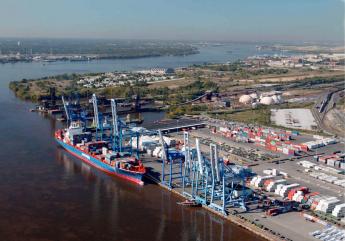
|
| Ports of Philadelphia |
When federal appropriations are doled out, it is a great advantage for the Port of Philadelphia to appeal to six U.S. Senators. However, the overlapping control of port operations can come close to paralysis. In short, we may have less chance of agreement on what we want -- but a greater chance of getting it. Right now, the ports of the world are struggling to adjust to revolutions of containerized cargo and gigantic oil tankers, plus political pressure from concern about the environment.
Some of the main arenas of our gladiator fights are as follows:
DRPA: The Delaware River Port Authority operates several large bridges, the PATCO high-speed subway line, and the cruise terminal, all leading to control of potentially large sources of revenue. The 1992 Congress expanded its charter to include the economic development of the port region.
SJPC: The South Jersey Port Corporation owns two marine terminals in Camden, and is planning a third in Paulsboro.
DSPC: The Delaware State Port Corporation operates the Port of Wilmington, DE.
PRPA: The Philadelphia Regional Port Authority has little to do with city politics, but is an arm of the state government of Pennsylvania, operating 7 marine cargo facilities, and planning more.
In addition, every county, city, and town along the riverbank has some degree of authority. Every business and union involved in regional or international trade is desperate to protect its interest in the politics of port regulation. Lately, the Homeland Security Agency has taken a large role. Scientists, engineers, fishermen, oil refinery operators, economists, and others abound. The news media convey their own opinions and the opinions of others. Opinions abound because most issues about ports are important.
In addition to the traditional cargoes of coal, petroleum, iron ore and forest products, which are mostly declining in importance, the rising cargoes include meat, cocoa beans, and South American fruit. General, or casual, cargo tends to be more valuable than bulk cargo, but greatly complicates the Homeland Security risks. The ratio of imports to exports is important because it is expensive to have a ship return empty. Shippers will, therefore, favor a port where there are expectations of return cargo. Oil tankers are particularly likely to return empty since their ballast is mostly river water; but, who knows, perhaps global warming will make dirty river water seem valuable to some tropical oil producer. A quirky problem is that most of the crude oil entering East Coast ports are currently coming from Nigeria, a notoriously corrupt nation. This has led to a thriving business of car-jacking in the Philadelphia suburbs, with the stolen cars promptly packed in empty containers returning to Africa.
Of the 360 major American ports, the Delaware River ranks second in total tonnage shipped, and eighth in the dollar value of the cargo. Every year, 2600 ships call into our port, which claims to employ 75,000 people. According to Bill McLaughlin of the PRPA, the future of the port will depend on the settlement of three major disputes:
1. Deepening the Channel. The historical natural level of the river is 17 feet, artificially deepened to 40 feet up to the level of the Walt Whitman Bridge. It sludges up by two or three feet every few years, so dredging is a continuous issue. The enlargement of tankers and container ships has led to a need to deepen the channel to 45 feet. It is true that the Wissahickon schist pokes up at Marcus Hook and will have to be blasted out, but mainly the issue is dredging up the gunk on the river bottom, and hauling it away somewhere. In Delaware Bay below Pea Patch Island, the bottom is sandy and hence valuable. The State of Delaware has plans for riverfront development, and would actually like to have the 8 million tons of sand, so no problem. The 7 million tons of clay and silt which must be dredged out of the upper Delaware River channel for a 45-foot depth is more of a problem, but users can be found for most of it. Or so the Pennsylvania representatives maintain; the New Jersey representatives led by Congressman Rob Andrews say it would be an environmental disaster to dump a thimbleful on New Jersey. Feelings get pretty hot in these things. The Haddonfield representative is portrayed as selling out his district in order to further his own state-wide aspirations, acting on the orders of North Jersey politicians who dominate New Jersey politics, who want to lessen competition with the Port of New York, which also shares a border with New Jersey. Feelings are not soothed to see the Port of New York deepening its channel to fifty feet while resisting forty-five in the Delaware port.
The document currently at the center of this interstate dispute is called PCA, the Project Cooperation Agreement. New Jersey won't agree to sign the proposal, which contains clauses to remove the DRPA from authority and replace it with PRPA(essentially transferring control and revenues from Philadelphia to the State of Pennsylvania) as the "non-federal sponsor". PRPA would then enter into a contract with the Army Corps of Engineers to get the work done.The price, probably low-balled, is $219 million, to be compared with the Port of New York's dredging price (probably high-balled) of $50 billion. There are, of course, a great many features of this political negotiation which are unlikely to appear in print.
2. Southport. The grand plan for the Philadelphia Port is to center on an intermodal complex of piers, railroads, and highways which would extend as a continuous terminal from the Walt Whitman Bridge to the old Naval Yard. No doubt this idea is linked to the round-the-world concept of Philadelphia as a way station from India to Vancouver, overcoming the empty return cargo problem by never looking back. Good luck.
3. Monetizing the Port. Like the turnpikes, ports could be sold to private investors. Of course, that could extend to selling the property to foreign investors, triggering the nationalist reaction readily observed when port management was once offered to Abu Dahbi. It could well give a new meaning to the expression, being sold down the river, but who knows maybe it's a good idea. When you criticize motives it never bothers real political pros, because it's simple to say you don't have such motives, and who knows. But the people seriously involved in government finances say they most fear that the do-gooders will be allowed to sell or lease publicly-owned facilities to improve the financial balance sheet. And then the pros will just take the money and use it to pay interest on more borrowing.
WWW.Philadelphia-Reflections.com/blog/1337.htm
Forty Days Before the Mast
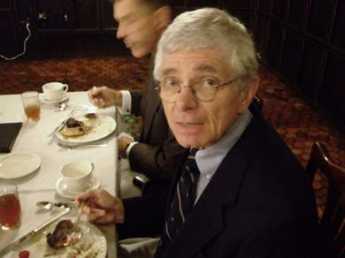
|
| Dick Watson |
Most Americans would like to lose weight, particularly if they could eat, and eat some more, at the same time. Dick Watson recently told the Right Angle Club about an adventure cruise on a sailing ship in the South Pacific, where he and everyone else ate huge mounds of delicious food, but still lost 12 pounds in a month. About twenty of these voyagers spent eight thousand dollars for the privilege of working as sailors for a month on an authentic pre-steam brigantine, sailing from Aukland to Easter Island. Dick took fourteen hundred beautiful photos of the experience, but most of his audience sat transfixed at the description of the horrors of sailor life. Not your average luxury cruise.

|
| Moshulu |
A brigantine is about an eighth the size of the Moshulu parked in Penn's Landing, and definitely does not plow the waves. Bobbing like a cork with every ripple, the ship "rode" waves throughout this "Pacific" cruise that averaged six meters or about twenty feet high. It thus follows that every single voyager was deathly sea-sick for the first two or three days; welcome to the bounding main. In spite of excruciating incapacity, sailors are not excused from standing watch; that's just about the first law of the sea. However, after a few days, this problem seems to go away for almost everyone and becomes only an initiation rite in retrospect. What doesn't go away is the wind, the cold, and the rain. Climbing the rigging gets you up to the fighting top, a wooden platform forty feet above the deck. Bigger ships sometimes have a hole in that platform to crawl through, but brigantines don't have rubber holes. You climb the mast and work your way out to the edge of the platform hanging upside down, then drag yourself up and over the edge. Once you are there, you can attach your safety belt, but the transition depends entirely on having enough strength in your hands to hold on while the ship rocks from side to side, forty feet below. Above the fighting, the top is another fifty feet of climbing, as the shrouds (ropes) which are attached to the top narrow down to the point where there is no longer room for your foot unless you turn it sideways. Ballet dancers learn to walk on their toes, but walking and climbing on the side of your foot is a step beyond excruciating.
Perhaps it is the good thing our ancestors came over to settle America that way. Except for a few people like Benjamin Franklin they gladly gave up all thought of returning to the home country. However difficult it may have seemed to cope with the Indians and all, they were going to be Americans forever. Other people could fight wars about events that took place in 1384. We weren't going to worry about that sort of thing because we were not going back, ever.
WWW.Philadelphia-Reflections.com/blog/1323.htm
Chester: To the Dark Tower

|
| William Penn |
Chester is the original word for Castle in old English, and accounts for towns called Manchester, Lancaster, Dorchester in the Midlands of England. Although much is made of his Welsh ancestry,William Penn grew up and lived in the neighborhood of Manchester. When he first landed in his new colony, he named the place Chester before deciding to move upriver to be above the mudflats and snags at the abrupt turn of the river where we now have an international airport. On several occasions, this protection from pirates and invaders made it possible to remain rich and prosperous without abandoning Quaker pacifist principles. As a further bit of history, the second public reading of the American constitution took place in the courthouse at Chester. During the industrial revolution, Chester became a mighty industrial town somewhat in advance of Philadelphia. The industry has, sadly, abandoned Chester.
Chester repeats the age-old tradition that slums are created when towns are abandoned, making cheap housing available. There's even a particular Chester twist to this principle: the old Sun Shipyards have been turned into a casino. Now, that will create poverty if anything will.

|
| Amtrak's Northeast Corridor |
Peter Barrow is a local real estate man who is determined to lead a revival of the old Chester, and certainly makes a good case for its future. Although much of the city was abandoned, the infrastructure remains. The roads, sewers, water supply, railroads, port facilities may be old but they are essentially intact, making revival much cheaper. Chester is still served by the R2 train from Philadelphia to Wilmington, and is on the main line of Amtak's Northeast Corridor. It's now near the airport, and near the electronics industry developing in Chester County along Route 202. Those things are economic drivers, and they are social ones, too. The old Chester urban Democratic machine and the rural Delaware County Republican machine can no longer afford to remain ossified in perpetual denunciation, in the face of new residents with new outlooks on things. So, there's agitation for reforms and both votes and discontent to propel it forward.
Given a magic wand, the one thing Mr. Barrow would change would be education. The public schools are undisciplined and unsafe, and mobilized by the teachers' unions to resist charter schools no matter what. Things have even gone to the point where Widener University is thinking about starting a charter high school, and the more graduates of charter schools the more momentum builds up for still more charter schools. Hidden in this struggle are two less defensible issues: parochial schools and vocational schools, pro, and con. The struggle over church schools goes back to the founding of our country in the sixteenth century and firmly resists any objectivity about whether parochial schools are better schools, or not. For them, that's not the point. The other tradition at play here is the historic opposition to vocational schools by trade unions. This one might be a little easier to work with since resistance to the development of more plumbers and carpenters was understandable enough during the industrial days of the city, but really is no longer relevant in an era when we now must import illegal immigrants to serve our needs in the mechanical trades.
Chester seems to have a chance to get its act together. Success or failure of this important the struggle could well depend on one or the other of the entrenched political machines, urban and suburban, seeing an opportunity -- and grabbing it.
WWW.Philadelphia-Reflections.com/blog/1322.htm
Chinese North
Mary Scott was recently introduced to the Right Angle Club by Buck Scott her father (and last year's program chairman.) Mary is fluent in Mandarin, lives in Beijing, and has a PhD. from Princeton. Although her luncheon talk had some of the features of a very polished travel talk with slides, it was considerably deeper than that.

|
| Forbidden City |
We learned the exiting news, easily confirmed by Google Earth, that the streets of both Beijing and Philadelphia are laid out in north-south, east-west squares. As we have noticed, Philadelphia was laid out with a magnetic compass, so Broad Street is 6 degrees off true North. Beijing, on the other hand, is almost exactly true North and South. While it is unclear how this was done two thousand years ago, it seems a likely conjecture that the Chinese architects probably used the North Star as a guide. This would have been in keeping with their notion of the Forbidden City as the center of the universe. Everything revolves around the Emperor, just as all other stars revolve around the Polestar.
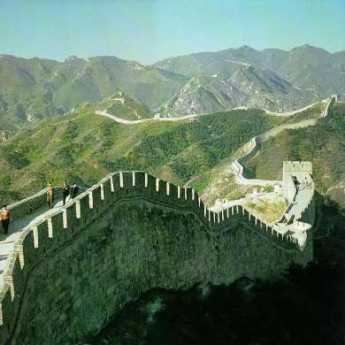
|
| Great Wall |
With primitive communication, and possibly even with the modern electronic variety, it is difficult to maintain control of a large empire without decentralizing. The ancient Chinese method was to put the many sons of the Emperor in charge of local districts, which got them out of Beijing where they were only making trouble, and assigned them the job of fighting with the neighboring Mongol tribes which would keep them busy. For this reason, the Great Wall is really many great walls, as the frontier advanced and retreated. When the Emperors died, there was always a major problem of succession, but at least each son had a military and administrative track record which reduced the number of aspirants to a handful of the biggest baddest ones.
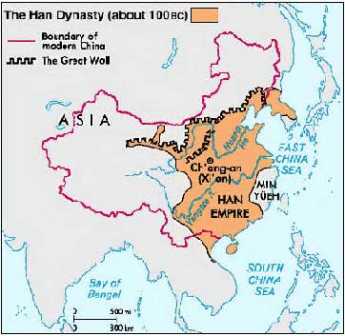
|
| Han Dynasty |
The Great Wall resembled a dragon, the symbol of the Emperor. It thus projected the image of his power out to the edges of the Empire. It had a road running on its top, greatly facilitating the shifting of defensive troops. As a defensive barrier it was only fair, having been breached many times, and on one occasion the Mongols even took the Emperor prisoner for ransom. However, the Wall's underlying purpose was to inhibit immigration, where it was probably reasonably effective. While at first the Han dynasty was mostly concentrated around the capital city, the Han Chinese gradually drove out, starved out or frightened out the others throughout the entire Empire. It is possible to see this relentless process in the recent treatment of Tibet. The underlying thought has been that if you don't exterminate them, eventually they will exterminate you.

|
| Tibetan Buddhism |
The Chinese prescription for domination has always been cultural as well as military. The Emperor was divine, far above other men. The symbolism of the dragon, of the golden color, and even the imposition of coherent architectural design on the city suggested his presence everywhere. Conversely, Tibetan Buddhism was a cultural threat from abroad, to be stamped out whenever it was safe to do so. And the recent policy of one child per mother leads to depopulation, which in turn will surely make the fecundity of neighbors a threat to China.
For thousands of years, the Chinese have worked out a system for just about everything except for peaceful succession of its rulers. That continues to be the case today, and we all better hope they eventually figure something out.
Furniture for the Horse Country

|
| Douglas Mooberry |
Low-end furniture for America is now mostly made in China, and seldom made of wood. Truly American cabinet making tends to be high-end, and high priced. That tendency goes to some sort of extreme around Unionville in Chester County, where a 25-year old company named Kinloch Woodworking holds pride of place. The owner, D. Douglas Mooberry, picked the name Kinloch at random from a map of Scotland, but his selection of southern Chester County was not an accident. The influence of nearby Winterthur has infused that whole region with an interest in fine furniture craftsmanship, and museums like the Chester County Museum and others throughout the nearby Pennsylvania Dutch country provide an ample source of authentic pieces to serve as examples. There's one other factor at work. As Doug Mooberry quickly noticed, people with money usually have lots of it. There really is a market for $28,000 tall case clocks, $18,000 highboys, and $12,000 tables -- if you can convince people in Chester County you are really good.
Although this 12-person company repairs antique pieces, it does not make exact reproductions. It produces new pieces in the old style of the region, based on careful analysis and evaluation of museum pieces from earlier times. Kinloch once aspired to equal the quality of the early artisans, but now aspires to surpass them in quality of materials and workmanship. The more conventional stance of fine artists is to attempt to excel in today's current style, whatever that may be, probably "post-modern". Kinloch artists, however, choose to excel in the style of a long-past era, taking care not to claim the product is antique. Artisans grow up in cooperative clusters; there's a world-famous veneer company nearby and a pretty good hardware company, although the best craftsmen of furniture hardware are still found in England.

|
| Chippendale Table |
The characteristic style of Chester County furniture in the Eighteenth Century was a mixture of two neighboring cultures, Queen Anne, Chippendale, ball and claw Georgian style of Philadelphia; and the "line and berry" inlay style of the Pennsylvania Germans. If carefully executed, this hybrid style can be very pleasing, and you had better believe it requires painstaking craftsmanship. Others will have to explain the significance or symbolism of intersecting hemi-circles in the lines, and the inlaid wood hemispheres, the berries, at the end of the lines. But the technical difficulty of laying strips of 1/16 inch wood in curved grooves only a thousandth of an inch wider, or the matching of 3/8th-inch wood hemispheres into hemispheric holes gouged out of the main piece -- making the surfaces of the inlays perfectly smooth -- is immediately obvious to anyone who ever tried to whittle. Ultimately, however, true artistry lies in combining two unrelated styles without producing an aesthetic clash. By the way, you would be wise to wax such furniture once a year.
The factory is on Buck and Doe Run Road, and here's another culture clash. At one time, Lammot du Pont cobbled a 9000-acre estate out of several little country villages. In 1945 it was sold to the Kleberg family of Texas, the owners of the King Ranch. Robert Kleberg was an admiring friend of Sam Rayburn but treated the oafish Lyndon Johnson as his personal political gofer. From 1945 to 1984 Buck and Doe was used as one of several remote feedlots for Texas Longhorns bred to Guernseys, the so-called Santa Gertrudis breed. Originally, Texas cattle were seasonally driven to Montana for fattening, then on to railheads for the stockyards. As farmers began to build fences interfering with the long drive over the prairies, it became cheaper to fatten cattle closer to the markets. So satellite feedlots like Buck and Doe Run were developed. You can pack more cattle in a rail car when they are younger and smaller, and advantage can be taken of price swings by suppliers who are close to the market. In this case, the markets were in Baltimore. Since the King Ranch is larger than the state of Rhode Island, such 9000-acre farms were pretty small operations in the view of the Texas Klebergs, an opinion they did not trouble to conceal from the irritated local gentry. The point was even driven home in high society circles by holding large parties at Buck and Doe Run, allowing guests to wander around the roads, unable to find the house of their host even though they had been on his property for most of an hour. In 1984 the Buck and Doe was sold to Art DeLeo, who is busily converting it into a nature conservancy.
Doing Well, Doing Good.
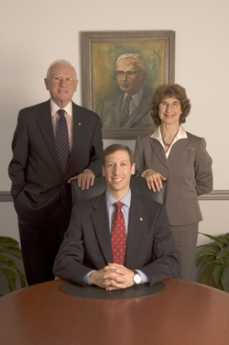
|
| Lynmar Brock |
Lynmar Brock is a Quaker, so what he does is surprising. He lives on a farm, but is Chairman of the Board of a food distribution corporation. He's also chairman of several other boards. He's written several books, and among them, a novel Must Thee Fight? relates the tribulation of one of his pacifist ancestors who nevertheless became a soldier at the Battle of Brandywine. The theme of this emotional conflict parallels the author's own struggle over being a conscientious objector who ultimately volunteered for the Navy because he felt he could not stand by while others fought his battles for him. The face of the soldier with a musket on the book jacket is his own.

|
| Rotary Seal |
When American forces recently entered Afghanistan, a great many people were forced to become refugees. Lynmar Brock was on the board of Rotary International, where a decision was made to provide relief for the refugees, and Mr. Brock flew over to lead the effort on the ground. Rotary raised $2 million almost immediately, and the task was to translate the money into something the refugees really needed. Since "shrinkage" is a common fate for refugee shipments, Rotary bought locally. They were able to distribute 83,000 pairs of shoes, 53,000 blankets and similar quantities of a number of other basic needs. Ultimately, the three-year effort raised $115 million and distributed items in the millions. It was important to give the goods to the local tribal chief, who then redistributed to the members of the tribe. To give it directly would undermine the authority of the chief, very likely provoking him to interfere with it. Accordingly, it is essential for relief workers to make friends with the chieftains, and it is essential to avoid the appearance of being a sap. All of the clothing was stamped with a big indelible yellow Rotary Seal; if it turned up in the black market, it would still be obvious what its source had been. At the same time, it was essential for donors not to appear to be soldiers. One of the missions of the group was to show the Afghans that Americans were real people who cared, and not all were soldiers. That they were successful in this way was brought out by one tribal chief coming forward and saying, "Teach us English. It's the language of the world."
Some influential Rotarians are active in American ophthalmological circles, and arranged to have American eye surgeons extract a great many cataracts from Afghans otherwise destined to a life of blindness. Since the Taliban routinely poisoned the wells, it was vital that farmers like Lynmar Brock were able to show how to repair or replace the local water supply. It might have been better to replace opium farming with tomatoes, but a compromise was made to replace opium with marijuana. That's an improvement, of sorts. The danger inherent in this work must not be shrugged off. All vehicles of foreigners were preceded and followed by at least six local soldiers. As the cavalcade moved from one tribal area to another, the soldiers were changed for soldiers of the new tribal area; their loyalty just had to be trusted. And, indeed, the co-chairman of the committee was mysteriously murdered one day.
The Rotarians return home full of praise for the U.N. field workers, mostly European, who are actually engaged in foreign relief work. The headquarters staff back home at the U.N. are described with only a shrug that speaks volumes, but it is useful for us all to keep the distinctions in mind.
Lynmar says it's great to be home. In his busy life there's work to be done on the farm, and in his corporation, and writing another novel. And there is supervision also needed for the Rotary efforts in the Ivory Coast. It's not completely certain, but sometimes he actually gets some sleep.
Mexico Goes to Morocco
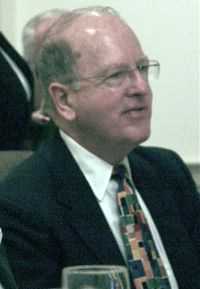
|
| Ted Burkett |
For years, the Right Angle Club has heard rumors that Ted Burkett is the Pied Piper of the Mexico Society, touring Mexico from one end to the other. Last year, he pulled a switch, and went to Morocco. The Right Angles were treated to a fast slide-show of about 200 pictures of the two-week trip.
Since most photographers admit they take five bad ones for every good one, that represented about a thousand snapshots, or eighty a day. Confessions had to be made: five or six photo enthusiasts in the group shared their best for the final product. Even so, anyone who has tried it knows that Ted must have spent weeks editing the final product. And it's all over in half an hour.
Things look pretty good in Africa, especially if you like souks. Casablanca, Fes, Marakech, the Atlas Mountains, all in living color. It takes nerve to do it, but those who bought stuff in the souks were able to ship it home, on time and intact. No one got sick except one person who was sick before the trip started and didn't have the judgment to cancel.
It all sounds so attractive that the idea inevitably comes up: why doesn't the Right Angle take trips, too? I'm sure Viscount Jennings would be glad to entertain us in his home town.
Quaker Efficiency Expert: Frederick Winslow Taylor 1856-1915

|
| F.W. Taylor |
For at least seventy-five years after Fred Taylor turned it down, any rich smart Philadelphia Quaker attending Phillips Exeter would have been automatically admitted to Harvard. We don't know why he did it, but instead F.W. Taylor just walked a few blocks down the hill from his Germantown house and got a job at the Midvale Steel Company as an apprentice patternmaker. During the twelve years, while he rose to become chief engineer of the company, he took a correspondence course for a degree in mechanical engineering at Stevens Institute and invented a process for making tungsten steel, called high-speed steel. That made Midvale Steel rich, but Taylor was going to make Philadelphia rich, and after that, he was going to make America rich. When he died, he was widely hated.
Evidently his lawyer father greatly admired German efficiency, having sent little Freddy to a famous Prussian boarding school where he was in attendance at the time of the
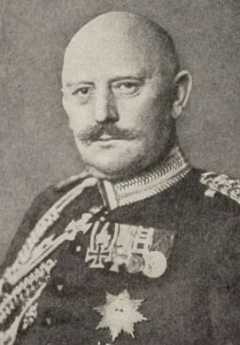
|
| General von Moltke |
Battle of Sedan. General von Moltke had used Prussian efficiency and discipline to defeat those indolent lazy French, and Fred Taylor evidently absorbed and retained these stereotypes for the rest of his life. Whatever he was looking for at Midvale Steel, what shocked him most was to find workers "soldiering on the job". That's a Navy term, by the way, invented by sailors to describe the useless shipboard indolence of any Army they were transporting. Taylor later went to Bethlehem steel, reduced the number of yard workers from 500 to 180, and was promptly fired. It seems that most of the foremen at the plant were owners of local rental houses, which were emptied of tenants when Taylor reduced the workforce. Even management came to mistrust Taylor. When the railroads wanted a rate increase, Louis Brandeis defeated them with the argument that they wouldn't need higher rates if they adopted Taylor's system of efficiency. In his later years after he became enormously rich, he toured the country giving speeches without fees, promoting the doctrine of finding the one best way and then doing everything that way.
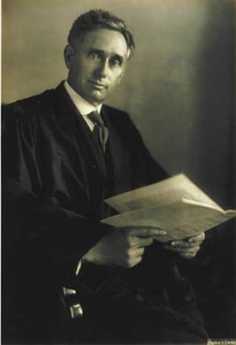
|
| Louis Brandeis |
Over time, Frederick Taylor had come to see that the industrial revolution had proceeded to the factory stage by merely bringing craftsmen indoors, each one treasuring his little trade secrets. Bringing the point of view of the company's owners onto the shop floor, Taylor could see how vastly more profitable the steel company would be if all those malingering tradesmen would stop soldiering on the job. No doubt the young Quaker soon learned that little was to be accomplished by remonstrating with workers, just as bellowing foremen had learned that bullying was also useless. Out of all this familiar scene emerged Taylorism, the idea of paying financial incentives to those who produced more, splitting the rewards of efficiency with the management. It sort of worked, but it didn't work enough to satisfy F.W. Taylor. When he walked around with a stopwatch, he collected the data showing how much more might be produced if the workers were perfectly efficient. Not only did that create the stereotype of the stop-watch efficiency expert, but it also provoked Congressional hearings and federal law against stopwatches which stayed on the books from 1912 to 1949. Although management responded by forming dozens of Taylor Societies to honor the approach, the unions invented the term "Taylorism" and bandied it about as the worst sort of epithet. Curiously, the Taylor approach proved to be enormously appealing both to Lenin and Stalin, who applied it as a central part of their five-year plans and general approach to industrialization. As we now all recognize, the Communist approach was a two-tier system instead of the three-tier system that was needed. It isn't enough to have a class of comrades called planners and another called workers; you need a layer of foremen, sergeants and chief petty officers in the middle. In addition to the elaborate time and motion studies leading to detailed written procedures, there needs to be an institutional memory for the required skills of the trade. In a funny sort of way, Fred Taylor the Quaker may have organized the downfall of the communist state before it was invented.

|
| Herbert Hoover |
Another peculiar outgrowth of Taylorism may be the partisan lines of our own political parties. If you trace the American ideological divide to the 1932 election of Franklin Roosevelt, you can see we are still fighting the battles of the depression. It happens that Herbert Hoover, another Quaker, was totally captivated by Taylorism. Not only that, he was adamant that to get rid of the depression all the country needed was to return to self-reliance, individual responsibility, and hard work. Those were qualities Hoover himself had in superabundance. One telling remark that he probably regretted saying but nonetheless firmly believed was, "If a man hasn't made a million dollars by the time he is forty, he can't amount to much." Franklin Roosevelt had the million all right, but his family had given it to him. The Cadburys and Clarks could have given it to Fred Taylor, too, but he chose to make it himself.
www.Philadelphia-Reflections.com/blog/1296.htm
Mesoamerican Ball Game
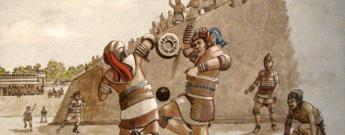
|
| Mexican Ball Court |
David Richards recently entertained and educated the Right Angle Club about his hobby interest in the Mexican ball game. Several thousand stadia have been excavated in Meso America, dating back three thousand years, so no other team sport can claim to have endured so long. The stadia vary in size from quite small (Copan) to quite large (Chichen Itza), the teams varied from two on a side to seven on a side, the rubber ball varied in size, and so on. But it has endured for many centuries as a team sport trying to get a rubber ball through hoops, on a playing field within a stadium. It had many fatal results, but it remains a little unclear whether these were player injuries or ritual human sacrifices.
The tour guides around these excavations are guilty of many fabrications for the enjoyment of gullible tourists but most of the real historical records were destroyed by the Spanish conquerors in their effort to eradicate idolatry. There were piles of skulls found rather near some ball stadia, so people were apparently killed there for some reason. A few wall glyphs depict some individuals being sacrificed by what seem to be priests. It seems possible the ball games were used to settle disputes, possibly wars, and in any event it looks as though many games were definitely played for keeps. Some players are depicted as holding clubs, so perhaps baseball can be traced back?

|
| Eagles with the ball |
The oldest stadia were constructed by the Olmecs, around Vera Cruz, about 1500 B.C. When the Spanish arrived, they found the ball stadium in Mexico City was the center of town and religious observance, so in typical Spanish reaction they built a cathedral on top of it. In this activity emerges the tradition that this particular ball court was regarded as sitting on top of the entrance to the underworld. Out of the various threads of fact and tradition, the general theory has emerged that the ball game in Aztec times had become a central ritual in the symbolism of life and death, of the transformation of human blood into maize, the transformative development of Mesoamerican culture.
That could not have been true throughout history, however. Ball courts have been found which were built for centuries before the Teotihuacan culture, and for centuries after that culture declined. During the Teotihuacan era of dominance, however, no ball courts. The religious association undoubtedly varied through that time, as well.
Central America had rubber trees, the rest of the world did not. The European invaders quickly took the six-pound rubber balls back with them, modified them and modified the rules. But all those different ball games do seem to trace back to this Mexican innovation. Human sacrifice is no longer an overt part of the experience, but team ball sports remain contact sports, with bloody consequences of some sort, no matter where they are played.
www.Philadelphia-Reflections.com/blog/1539.htm
Link to 2009
THIS concludes the yearbook of the Right Angle Club for 2008. To skip to the 2009 yearbook, click the indicated place below:
» Click here for RIGHT ANGLE CLUB 2009 «
| Posted by: Bilal | Mar 1, 2009 11:01 PM |
43 Blogs
SCUBA Tours of the Andrea Doria
 The Stockholm collided with the Andrea Doria and sank her in 1956 in 250 feet of water. Lots of weekend visitors still wander around inside the ship.
The Stockholm collided with the Andrea Doria and sank her in 1956 in 250 feet of water. Lots of weekend visitors still wander around inside the ship.
Philosophy Means Science in Philadelphia
 At least until he met Madame Helvetius, Benjamin Franklin displayed little interest in moral philosophy. His interest was in science, which was called natural philosophy in the Eighteenth Century. The American Philosophical Society is America's oldest and most prestigious society of scientific scholars. If investing is a science, the APS is good at that, too.
At least until he met Madame Helvetius, Benjamin Franklin displayed little interest in moral philosophy. His interest was in science, which was called natural philosophy in the Eighteenth Century. The American Philosophical Society is America's oldest and most prestigious society of scientific scholars. If investing is a science, the APS is good at that, too.
Pakistan and Democracy
 A former resident of Pakistan loves Democracy, but explains why it has been unsuccessful in Pakistan.
A former resident of Pakistan loves Democracy, but explains why it has been unsuccessful in Pakistan.
World Finance, Columbus Day 2008

WRTI, Classical Music and Jazz
 For a city with such a strong musical presence, it is surprising that Philadelphia has only one classical music radio station.
For a city with such a strong musical presence, it is surprising that Philadelphia has only one classical music radio station.
John Head, His Book of Account, 1718-1753
 The equivalent of the rosetta stone for colonial commerce had been sitting on George Vaux's shelf for six generations.
The equivalent of the rosetta stone for colonial commerce had been sitting on George Vaux's shelf for six generations.
Use the Internet for Your Club

Securities Trading Across Time Zones
 Closing the securities markets for any reason causes disruptions. Patchwork solutions are often devised. But continuous global 24-hour trading is an idea which conflicts with the need for everybody to get some sleep.
Closing the securities markets for any reason causes disruptions. Patchwork solutions are often devised. But continuous global 24-hour trading is an idea which conflicts with the need for everybody to get some sleep.
Vote Counting, Past and Future
 Voting law changes followed the contested 2000 Presidential election, but U.S. Supreme Court still comes out looking pretty good. Close elections will always cause problems, some of them brand new ones.
Voting law changes followed the contested 2000 Presidential election, but U.S. Supreme Court still comes out looking pretty good. Close elections will always cause problems, some of them brand new ones.
The Trigger and the Cliffhanger
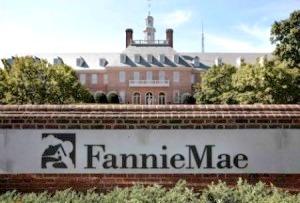 It was inevitable that someone would pull a trigger, and market gossip is now shaking loose who actually did. The cliffhanger to come is the insolvency of Fannie and Freddy.
It was inevitable that someone would pull a trigger, and market gossip is now shaking loose who actually did. The cliffhanger to come is the insolvency of Fannie and Freddy.
Turtles and Bananas
 Snapper soup can be made from snapping turtles, but the historical source of the ingredients has been shipped from the Caribbean.
Snapper soup can be made from snapping turtles, but the historical source of the ingredients has been shipped from the Caribbean.
Lawn Tennis at the Cricket Club
 Lawn tennis is slightly older than tennis on clay courts, but it's harder to maintain grass than other surfaces, so it's less common.
Lawn tennis is slightly older than tennis on clay courts, but it's harder to maintain grass than other surfaces, so it's less common.
Urban Bridges
 The Episcopal Church has found a practical way for its prosperous suburban branches to form partnerships with struggling urban parishes.
The Episcopal Church has found a practical way for its prosperous suburban branches to form partnerships with struggling urban parishes.
The Corinthos Disaster
 We hope the 1975 Corinthos disaster proves to be the worst fire in Philadelphia history; it's hard to imagine a bigger one.
We hope the 1975 Corinthos disaster proves to be the worst fire in Philadelphia history; it's hard to imagine a bigger one.
Google Earth Tour of Franklin Locations
 Every place B. Franklin is known to have visited is included in this tour by Bob Florig.
Every place B. Franklin is known to have visited is included in this tour by Bob Florig.
Reading Books Compared With Computer Viewing
 Authors universally compose their work on personal computers. Much more resistance to reading books on computers comes from readers, who dislike the glare of computer monitors on their eyes, the extra cost, and the cumbersomeness, and the trouble to learn how. However, storage is cheaper on servers than libraries, marketing is easier and maybe cheaper online, and technology will inevitably increase the advantages of computers. Right now, computers are ruining the book trade, not sweeping it aside.
Authors universally compose their work on personal computers. Much more resistance to reading books on computers comes from readers, who dislike the glare of computer monitors on their eyes, the extra cost, and the cumbersomeness, and the trouble to learn how. However, storage is cheaper on servers than libraries, marketing is easier and maybe cheaper online, and technology will inevitably increase the advantages of computers. Right now, computers are ruining the book trade, not sweeping it aside.
Rise and Fall of Books
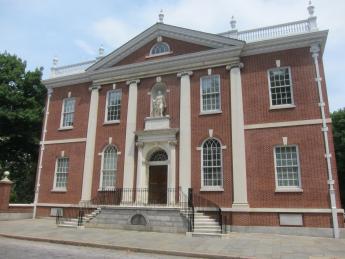 The The Director of America's first library sees books as mainly a 19th Century phenomenon.
The The Director of America's first library sees books as mainly a 19th Century phenomenon.
South Amboy Explodes
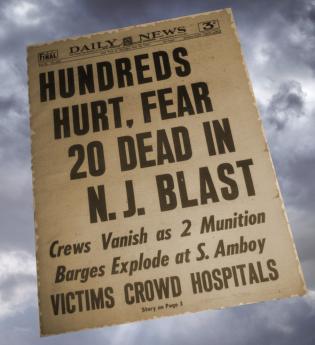 On May 18, 1950, South Amboy, New Jersey blew up, breaking windows of five counties in its neighborhood.
On May 18, 1950, South Amboy, New Jersey blew up, breaking windows of five counties in its neighborhood.
The Man Behind the Mann
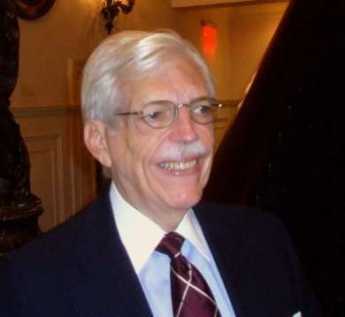
China Bubble
 Poor nations don't know how to spend their money, so they save it. When they eventually spend their money it inflates prices and wages and destroys their competitive advantage. To prolong their happy period of prosperity, the Chinese government exported their savings -- and their inflation -- by buying U.S. Treasury bonds. Their inflation became our inflation, our bubbles, and our disrupted banking system.
Poor nations don't know how to spend their money, so they save it. When they eventually spend their money it inflates prices and wages and destroys their competitive advantage. To prolong their happy period of prosperity, the Chinese government exported their savings -- and their inflation -- by buying U.S. Treasury bonds. Their inflation became our inflation, our bubbles, and our disrupted banking system.
Federal Reserve Changes Its Business Model
 On March 16, 2008, the Federal Reserve stepped in to stop an impending bank panic. It also changed the rules of the game, rather significantly.
On March 16, 2008, the Federal Reserve stepped in to stop an impending bank panic. It also changed the rules of the game, rather significantly.
Volunteerism Needs a Business Plan
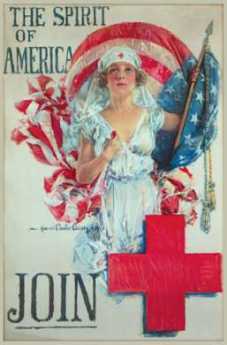 Volunteerism has declined in recent years because of conflicting demands made by gainful employment. The spirit of volunteerism has not diminished, it just needs a different business plan.
Volunteerism has declined in recent years because of conflicting demands made by gainful employment. The spirit of volunteerism has not diminished, it just needs a different business plan.
Gettysburg
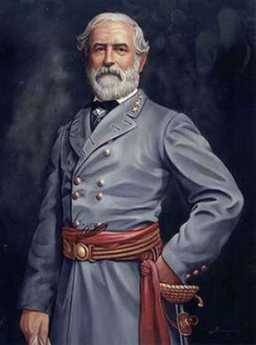 The strategy of both sides in the Battle of Gettysburg was shaped by the type of weapons in use.
The strategy of both sides in the Battle of Gettysburg was shaped by the type of weapons in use.
SCORE
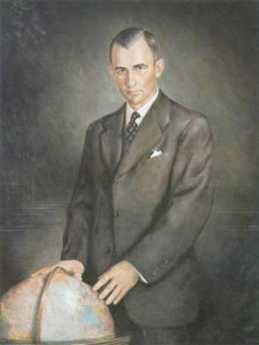 The Service Corps of Retired Executives has taken a new turn in Philadelphia, primarily serving minority start-ups, a majority of which are founded by black women.
The Service Corps of Retired Executives has taken a new turn in Philadelphia, primarily serving minority start-ups, a majority of which are founded by black women.
Onward, Christian Soldiers
 Like a fairy godmother, Jane Kroc has dropped a spectacular gift on the poor of North Philadelphia, and the Salvation Army. Opening in 2009.
Like a fairy godmother, Jane Kroc has dropped a spectacular gift on the poor of North Philadelphia, and the Salvation Army. Opening in 2009.
Galapagos As an Environmental Laboratory
 Charles Darwin spent very little time in the Galapagos Islands, but learned a lot. Tourists can do the same.
Charles Darwin spent very little time in the Galapagos Islands, but learned a lot. Tourists can do the same.
Camden Riversharks
 Camden NJ has a minor league baseball team which in some ways is more fun than the Major leagues. Fans certainly sit closer to the players.
Camden NJ has a minor league baseball team which in some ways is more fun than the Major leagues. Fans certainly sit closer to the players.
Second Amendment: The 28th Infantry Division
 Seldom regarded as a warlike state, Pennsylvania has one of only eight reserve divisions of the U.S. Army and the oldest.
Seldom regarded as a warlike state, Pennsylvania has one of only eight reserve divisions of the U.S. Army and the oldest.
Burlington County, NJ

Beaux Revival
 The Pennsylvania Academy of Fine Art staged a major revival of Cecelia Beaux, February through March 2008. Eighty-five examples of her work were on display, aiming to restore her to the prominence she deserves.
The Pennsylvania Academy of Fine Art staged a major revival of Cecelia Beaux, February through March 2008. Eighty-five examples of her work were on display, aiming to restore her to the prominence she deserves.
Commercial Academic Think Tank
 There are universities and there are think tanks. Philadelphia has at least one commercial consulting firm which combines elements of both.
There are universities and there are think tanks. Philadelphia has at least one commercial consulting firm which combines elements of both.
Report Identity Theft to the Secret Service
 Identity theft is now under the jurisdiction of the U.S. Secret Service.
Identity theft is now under the jurisdiction of the U.S. Secret Service.
Detroit Makes, Philadelphia Takes
 The heap of crushed auto bodies at the foot of Philadelphia's Platt Bridge is an important part of the regional economy.
The heap of crushed auto bodies at the foot of Philadelphia's Platt Bridge is an important part of the regional economy.
Port of Philadelphia
 The Port of Philadelphia has access to six U.S. Senators from its surrounding states, but the price to be paid is endless political wrangling.
The Port of Philadelphia has access to six U.S. Senators from its surrounding states, but the price to be paid is endless political wrangling.
Forty Days Before the Mast
 Before steamships, most of our ancestors spent a month at sea in a sailing ship and never would consider going back home if it meant another such trip. Here's a taste of what it was like.
Before steamships, most of our ancestors spent a month at sea in a sailing ship and never would consider going back home if it meant another such trip. Here's a taste of what it was like.
Chester: To the Dark Tower
 The ancient town of Chester struggles to revive..
The ancient town of Chester struggles to revive..
Chinese North

Furniture for the Horse Country
 Fine art is generally the product of rich people demanding something special from a nearby artisan community. Furniture making in Chester County is sort of like that.
Fine art is generally the product of rich people demanding something special from a nearby artisan community. Furniture making in Chester County is sort of like that.
Doing Well, Doing Good.
 A board member of Rotary International recently ran an Afghanistan relief program and wrote a novel about the Battle of Brandywine. He's a Quaker, lives on a farm, and is chairman of the boards of several organizations.
A board member of Rotary International recently ran an Afghanistan relief program and wrote a novel about the Battle of Brandywine. He's a Quaker, lives on a farm, and is chairman of the boards of several organizations.
Mexico Goes to Morocco
 For those who like warm dry climates in the Winter, Ted Burkett led the loyal Mexico Society members to a new one.
For those who like warm dry climates in the Winter, Ted Burkett led the loyal Mexico Society members to a new one.
Quaker Efficiency Expert: Frederick Winslow Taylor 1856-1915
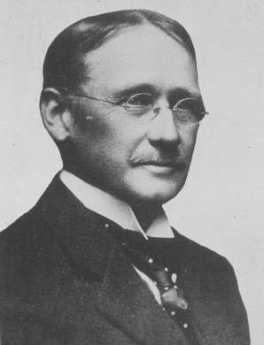 A rich Germantown Quaker boy became the world's symbol of the efficiency expert with a stop-watch, hated by Labor Unions but admired by Lenin and Stalin. He enriched the Midvale Steel Company with his invention of high-speed steel but was fired by Bethlehem Steel for eliminating too many employs. 000..0ees. Peter Drucker placed him in the class of innovators beside Darwin and Freud.
A rich Germantown Quaker boy became the world's symbol of the efficiency expert with a stop-watch, hated by Labor Unions but admired by Lenin and Stalin. He enriched the Midvale Steel Company with his invention of high-speed steel but was fired by Bethlehem Steel for eliminating too many employs. 000..0ees. Peter Drucker placed him in the class of innovators beside Darwin and Freud.
Mesoamerican Ball Game
 The team ball game was apparently invented by Olmecs about 3000 years ago. Soccer, football and maybe baseball are variants.
The team ball game was apparently invented by Olmecs about 3000 years ago. Soccer, football and maybe baseball are variants.